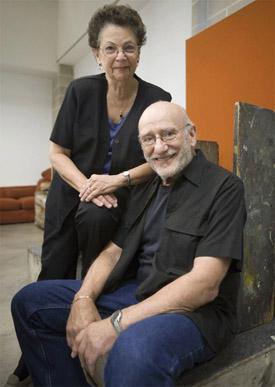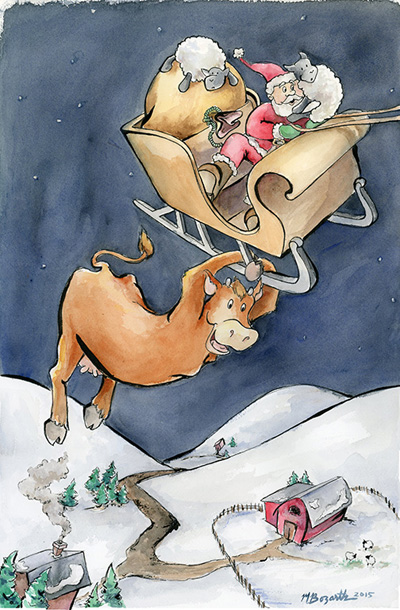Oak Street Treehouse – Heaven


In my painting career, I’ve gotten to illustrate heaven twice now. The first was for an illustrative portrait of my grandma. It was an oil painting where she was seated with several of us grandchildren (and kids from her church) around her. A man (our friend Keith Caleb) was standing with his arms raised to heaven, worshiping, and above him were the golds and warm tones of throngs of people in heaven all facing Jesus. It’s strange that the place where we will spend the most time (eternity!) is so little talked about in the church. It’s as though pastors are afraid to “get it wrong,” so they focus instead on life here and how to walk by faith. Not so my grandma. She LOVED learning about heaven and teaching about heaven. In fact, she led a Bible study on that subject for over 7 years with several friends and ladies from her church.
Grandma would have loved to see me working on Oak Street Treehouse #3: The Day They Had A Party. (I’m guessing she does know and saw me working on it, according to many people’s interpretation of the “Great Cloud of Witnesses” in Hebrews 12:1.) In Oak Street #3 an old gentleman from their neighborhood often visits the kids at their treehouse. He’ll sit and eat cookies, tell them stories, teach them songs in Spanish. And he shows them a photo of his wife who passed away years before. Someday he’ll see her again in heaven. Spoiler alert…an ambulance comes and takes Grandpa GG away one day. The kids find out soon afterward that he has passed away.

The Oak Street kids have never faced death before. They have had a puppy or goldfish die, but they can’t comprehend saying a permanent goodbye to someone they love. Honestly, even as adults we struggle with this. Death never feels “right” because we weren’t created to die. It wasn’t until Genesis 3 that death entered this world. And though it was conquered by Christ on the cross (1 Corinthians 15:55-57), we still live in the shadow of death (Psalm 23:4).
As in the previous Oak Street books, the kids message God for help in processing the loss of their friend and neighbor, Grandpa GG. God helps them see that they can celebrate the life of their friend because he is in heaven and they will one day see him again! I love the next scene in the book. Families from all over the neighborhood come out to celebrate George Gonzales’ life! I like the simplicity and innocence of this scene. The Oak Street kids have planned and decorated their treehouse. They’ve made cookies and lemonade, a poster where people can write their memories of Grandpa GG, and a board of photos sharing their own memories of time with him. What has changed in their situation? Is their loved one still gone? Yes. Do their hearts still hurt when they miss him? Yes. But they trust God. And the action of bringing people together to fellowship and celebrate reminds them that they have hope. Romans 8:22-28 says, “We know that the whole creation has been groaning as in the pains of childbirth right up to the present time…hope that is seen is no hope at all. Who hopes for what they already have? But if we hope for what we do not yet have, we wait for it patiently. In the same way, the Spirit helps us in our weakness. We do not know what we ought to pray for, but the Spirit himself intercedes for us with groans that words cannot express…And we know that in all things God works for the good of those who love him, who have been called according to his purpose.” In ALL things, good and bad, broken or whole, in spite of the evil in this world, God works for the good of those who love him. Romans 8:38-39 goes on to say that no thing (good, bad or evil, our present or future) can separate us from the love of God that is in Christ Jesus our Lord.

About the Artwork
The scene of heaven was one of my favorites to illustrate! I used bright colors, sweeping landscape to show the vastness of new heaven and new earth that we’ll one day get to explore. Grandpa GG is greeted by his wife but more importantly, he gets to shake hands with Jesus! Friends and family who’ve gone before him gather to welcome him in. I kept Grandpa GG and his wife in the same clothing and age of what the Oak Street kids remember him being because that is how they would imagine him in the scene. Jesus has the nail hole in his hand because Revelation 5:6 describes him as the only being in heaven whose scars from earth remain…he is known by his scars. No one can truly capture heaven in a picture book page. But I’m happy with the glimpse I was able to give readers.
The scene of the goldfish burial was another favorite to illustrate! When I Googled “goldfish burial” for ideas, I saw everything from plastic orange goldfish-shaped cases that people can buy online to a Pepsi-can cut open and stuffed with cotton as the final resting place for the beloved pet. The Pepsi-can was more in line with what the Oak Street kids would use. So, I took that idea and looked around my house for small containers similar in style to the metal can. My large toothpick box seemed just right! Half the top opens to retrieve toothpicks. I posed it and sketched the scene. The word “toothpicks” happened to be upside down when you open my container. But I like that touch! Seems to add a bit of innocent humor to the illustration.
The original plan was that Oak Street #3 would be the final in a trilogy. Dick Daniels has already mentioned ideas for a 4th book, so you can watch for that possibly in 2025. But at the time of illustrating this, I wanted page 32 to be a finale kind of shot. Dick and I discussed a montage of photos, and the resulting illustration you see above. The photo of his wife is stylized after several photos I found of older Hispanic women. However, Grandpa GG is based on my brother’s classical guitar teacher from college. From the moment Dick Daniels described the Grandpa GG character, I have pictured Ner Rojas in the role. He’s a teddy bear kind of gentleman who loves kids and is easily believable as the “Grandpa of Oak Street.” Ner also inspired the backdrop for the heaven scene. He is originally from Peru. So, I used Peruvian mountains sweeping down toward the group of people. And one of the people greeting him in heaven is Ner’s friend (and mine), Bill Rehr. These are the things we illustrators get to do! We weave our own stories into the imagery of a book. Ner and Bill have each lived out the verse that Dick Daniels chose for the back cover of this book. It is from Psalm 78 and says, “Listen…I’ll let you in on sweet old truths, stories we heard from our fathers, counsel we learned at our mother’s knee. We’re not keeping this to ourselves, we’re passing it along…so the next generation would know, and all generations to come – know the truth and tell the stories so their children can trust in God. Never forget the works of God.”
AMEN! I was blessed to be raised by parents and grandparents (even Great Grandparents) who told us the stories of God’s love. I was blessed to have mentors and “adopted” grandparents at church who also shared faith and love. If you are one of those parents or grandparents to the kids around you, THANK YOU! You are blessing the next generation and helping to fight the curse of this tired world. Whether your family has faced loss and death recently or not, I highly recommend the Oak Street Treehouse series to you, especially this 3rd book about heaven. These books make great baby shower gifts, birthday or Christmas gifts! You can find links for buying the books…and fun coloring pages or mazes…at our website: www.oakstreettreehouse.com – check it out today!
Oak St. Treehouse – New Kid

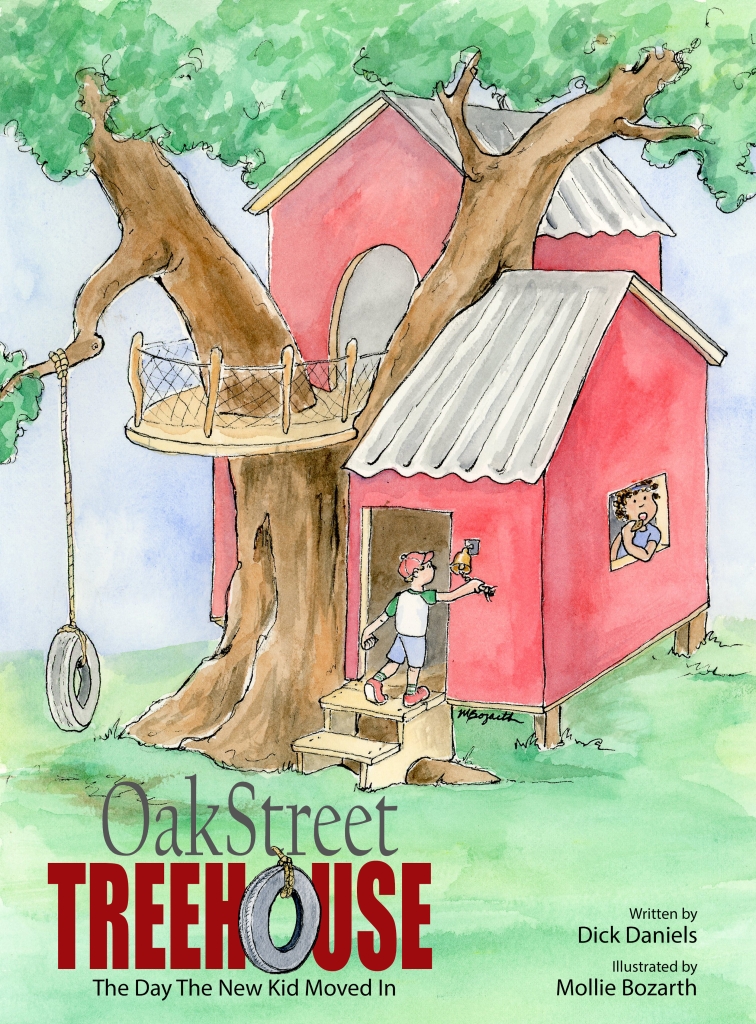
I remember being the “new kid.” It can be exciting in some ways, and scary in others! I was the new kid at age 11. I had just moved 900 miles and was starting 6th-grade. Some kids teased me because I had a “southern” accent. Of course, if they had been from Virginia (where I’d just moved from), they would have known that people in Alabama have a southern accent…Virginian accent is comparatively mild! Others teased the way I walked (my walk was average, but their comments made me self-conscious). Still others excluded me because I liked big floppy bows in my hair and had a pencil collection.
Thankfully, not everyone was exclusive or mean. I made plenty of good friends that year, including some lifelong friends. And at least one girl stood up for me against the bullies, proving what a true and welcoming friend can be. Perhaps because of those early experiences, I can be shy and careful when it comes to new things, new places, new friends. At age 28, I remember walking into a 2-week conference for my MFA in Illustration at the University of Hartford. I was rooming with a girl I’d never met, away from home for the first time in a while, and unsure what to expect. The head of the program (Carol Tinkelman…wife of Murray Tinkelman) pulled my roommate aside, asking, “Is Mollie okay? She seems awfully quiet.” And my roommate, perceptive gal that she is, replied, “I think she’s just taking it all in!” She was right. That’s how I function as a “new kid.” I tend to step in quietly, survey the scene, gauge whom I can trust and what’s expected of me, then go from there. By the end of the program (2 years later), I was honored to be asked to speak at our graduating ceremony. Obviously, I had acclimated by then!
I recently finished illustrating a children’s book titled Oak Street Treehouse: The Day The New Kid Moved In. In this book, our “new kid” is NOT shy! He’s friendly and adventurous, excited to meet all the neighborhood kids. However, they’re not so sure what they think of him. One of my favorite scenes to illustrate was a list they make of pros and cons as to “why they should include him.”

I love this illustration because (sadly) I can relate to it even as an adult! When I am part of an established group and someone “new” comes in, many of these petty thoughts run through my head. I may not be thinking about freckles…but we humans do tend to look at clothing, posture, and other visuals to make quick judgements as to whether we expect to “like” the new individual. We make random guesses about their personality and character, based on a few seconds of introduction. Then we get to the root of our problem: “He will eat our cookies. And, we’ll have to make room for him at the treehouse.”
There’s the rub! We have our comfort-zone; our group of people whose habits and expectations we’ve grown accustomed to; and our knee-jerk reaction is, “I don’t need anyone new! I don’t want to share my time, love, or emotional energy with someone new! I like things the way they are now!”
But, oh, how we miss out if we stay in that mindset! As I look around and behind me, SO many worthwhile friendships have developed from trying out new experiences and investing in new people. The stranger we welcome in can be a blessing we didn’t even know we needed. And, whether we “click” easily with the people we meet or not, our friendship and acceptance may be something they need as well. Spoiler alert. As the story progresses, God talks with the Oak Street Treehouse kids about the whole “new kid” issue. His advice? – “Sometimes the best gift you can give somebody is to include them.”
Whether you can relate to the new kid or to the established friend group, I hope you’ll check out Oak Street Treehouse: The Day The New Kid Moved In! It’s a great little story that connects well to the first Oak Street book – Oak Street Treehouse: The Day They Messaged God. Both are available on Amazon.com, or you can support my friend’s local bookstore in Virginia Beach by buying them through readvb.com. We’ve also set up a new website for the books! There you can find coloring pages, discussion prompts, links to hardcover or audible book copies. Check it out at OakStreetTreehouse.com! And the next time you have the opportunity to meet someone new, take a moment to step out and welcome them. You never know what friendship might be waiting around that corner.
Joy!

O sing a song of Cherubim that echoes round the hills
with sweet unearthly harmonies, and effervescent trills.
A joy held back since Genesis is overflowing now.
Tired earth absorbs the news, then sighs a gentle sough.The host, an army battle cry, proclaiming victory
for Word has taken human form, a first in history.
Then, bold, above the stable forms a bright and steady light;
a kingly star has pierced the curtain of our darkened night.Do not fear, for all of sorrow, hatred, pain and death
begins to come unraveled with one baby’s tiny breath.
The Prince of Darkness trembles as the angel armies sing
for Prince of Peace could usher in a new and holy reign.Safely swaddled, resting in the warmth of mother’s care
newborn babe with milky mouth, sleeps sweet and unaware.
Carpenter feels the fragile fingers grasp his calloused hand.
Exhausted, marveling at events he cannot understand.Stillness broken as the doorway fills with lambs and ewes.
Shepherds crowd the stable, then go out to spread the news.
Astrologers, well-versed in ancient Hebrew prophecy
begin their pilgrims’ journey, to anoint this Jewish king.And though the angel chorus does not reach his sleeping ears
old Simeon stirs, his spirit moved from long, expectant years.
Anna, in the temple, praying, fasting day and night
praises God for sending His redemption to her sight.Elizabeth croons a lullaby to calm her baby boy
as John begins to babble, clapping hands with sudden joy!
Quietly reflecting, she pauses in her tune
remembering his joyful leap when he was in her womb.Final notes and glory fade, the night is still again
text copyright 2020 Mollie Bozarth
veiled is the holiness that hummed in Bethlehem.
But souls awakened by the song can hear the echo ring
and feel their dry bones come alive as heaven and nature sing.
How do you write about Joy!? I could not approach this blog post as a discourse, lesson, or essay on joy. That would take the joy out of it! So, I’ve turned to another favorite form of writing – poetry. With poetry, we can enter into the scene of that moment in history we refer to as Christmas. The sights, the emotions, the electricity in the air on what would otherwise have been a boring night. I hope the words above capture something of that.
I painted the portrait as my Christmas card this year. As I did so, I wondered, “Can a baby truly feel or exhibit joy? Or is what I see in my niece’s excited face, pointed toes, and raised arms simply happiness or glee?” Then I remembered two things: 1. John (Jesus’ cousin…aka John the Baptist) is described as “leaping for joy” within his mother’s womb when Elizabeth and Mary are both pregnant. If a prenatal baby can experience and exhibit joy, then YES!, my niece could be joyful even in her babyhood. 2. Jesus says, “Let the little children come to me, and do not hinder them, for the kingdom of heaven belongs to such as these.” ~ Matthew 19:14 Whether Christian or no, we have seen the wonder and excitement in a child’s face that we long to have in our own hearts. Cynicism, hard knocks, and “adulting” can take us far from the simple innocent faith we had as children. The movie “Elf” is popular for that very reason! We wish we could be the adult whose enthusiasm at “the World’s Best Cup of Coffee” isn’t daunted by the reality of that coffee’s crappy flavor…an adult from whom joy and innocence overflow to even the most cynical around us. And, as Christian’s we aren’t excited about a crappy cup of coffee. We are excited about the Savior of all things reaching down into our messy lives and breathing redemption! Elf was misguided in coffee taste, but he was right about one thing: the best way to spread Christmas cheer is by singing loud for all to hear! The angels set an example two thousand years ago. My neighbors are spreading word about stepping out on our doorsteps and ringing bells together as a community on Christmas Eve. So, whether singing carols, singing in the shower, ringing bells, or yelling, “Wahoooo!” spread some joy this Christmas. That’s what the baby came for. That’s what it’s all about.
Plein Air Iris

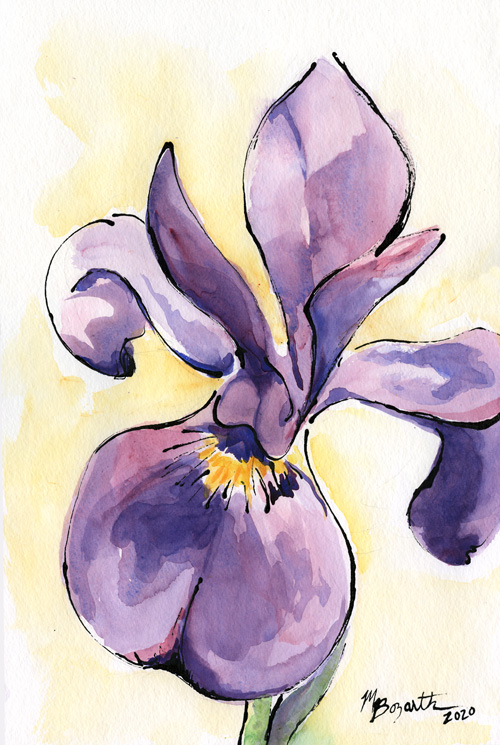
copyright 2020 Mollie Bozarth
Twenty years ago a professor took the small detail paintbrush out of my hand, replaced it with a LARGE 2″ brush, and told me I needed to loosen up. That professor was Rod Crossman. He’s retiring from Indiana Wesleyan University this month. So, this blog post is for him!
When Crossman handed me the large paint brush, my jaw dropped. I’m sure I looked longingly back at my tiny brush, looked at him to see whether he was serious, and sighed. Now, twenty years later, I often do/say to my students exactly what he did/said to me. What perfectionists and control-freaks don’t understand is that there is FREEDOM in loosening up! I’ll see a Drawing 1 student choking up on his pencil (holding it way down by the tip for “better control”) and show him how to hold the pencil almost at its eraser to create smooth, graceful sketch lines. I’ll see painting students lean in until their nose practically touches the canvas. So, I take the canvas, step back 5 feet, and say, “How does it look from back here?” They respond with, “Oh! That looks way better now!” Then I tell them they’re over-analyzing the work, need to take breaks, step back and see it in perspective. Finally, I’ll see Painting 1 kids struggling along with a tiny brush, using 50 marks to fill in an area where a larger brush could do it in one stroke. I take the brush away (just like Crossman did), hand them a larger brush, and say, “Try to capture it in one stroke!” Then I’ll follow up with more wisdom that was drilled into me in college, “Lay down a brush stroke, and leave it! Don’t overwork the painting. Let the mark be the beauty of piece. If you overwork it, you’ll make mud.”
What is our problem as artists? Well, we have many problems! We stare at a piece until we’re cross-eyed, but we hesitate to have other people look at and critique it because we might take their comments too personally. Yes, artwork and creation are very personal endeavors. However, if you want to succeed in the art realm, you’ve got to emotionally and physically step back from the work. Be willing for someone to tear it up and throw it away if that’s what it takes for you to excel or grow. I know one of my problems is that I want each piece to come out perfectly on the first try. This can lead to dragging a dead piece along, trying to breathe life into it when I should have given up, buried it, and started over long ago. Sometimes I’ll force myself to do a sketch or painting several times in slightly different ways (different cropping, angle, or media). This exercise pushes me outside of my mental comfort zone. And that’s where breakthroughs happen. I’ve seen students and peers have the opposite problem – they’ll restart a piece 5 times, feeling like they can’t capture on paper what they see in their head. Often they end up giving up entirely and moving along to some new vision or challenge. The result can be a lifetime of chasing the “perfection” you see in your head and never truly getting there…or never being satisfied when you do arrive, because “perfection” is such an abstract ideal.
All that to say, I sat in my backyard this morning with three goals in mind: 1. to limit myself in a very basic sketch, followed by inking with a carved stick dipped in India ink; 2. to do as Crossman taught me, working a large space (12×18 paper) with a large brush (Chinese calligraphy brush); 3. to stay loose and not overwork my washes. Inking with a stick is fun because the marks are unpredictable. You can get blobs and thin, dry lines. It creates a more rugged, free look. Sometimes I’ll ink with a Uniball black waterproof pen, but that line is too fine for the effect I wanted today. I took a wide array of brushes outside with me. The Chinese calligraphy brush worked best because it can achieve both wide swaths of wash and thin marks/lines, depending on how you tilt the brush or use the tip. So, all the other brushes (including a tiny one I’d brought out “just in case”) lay neglected on the table. I will admit, I lost a couple good marks where I lay down paint, thought, “oh, that’s perfect,” proceeded to tweak it slightly anyway, and lost the perfection in a wider stroke. However, there are several “lay it down and leave it” strokes in this study. One is a fun, “W” shape in the left-hand petal. Others are thin squiggles or wet-on-wet patches that captured exactly what I needed them to.
Is this painting a van Gogh Irises level of study? Heck, no! It’s more along the lines of DaySpring greeting card or stationery. It was a fun way to “play” on a Saturday morning. And, it accomplished what I set out to do – stay loose, capture light with patches of color and value, relax, ease up, have fun. Thank you, Rod Crossman, for handing me that intimidating brush twenty years ago! I definitely thought of you while plein air painting today.
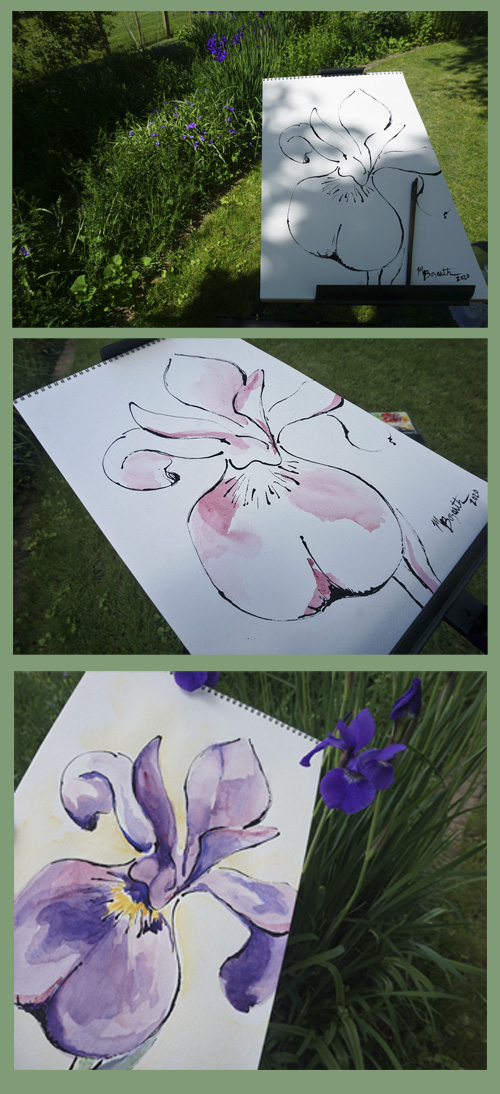
Fishers of Men
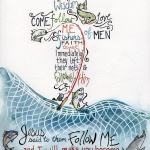
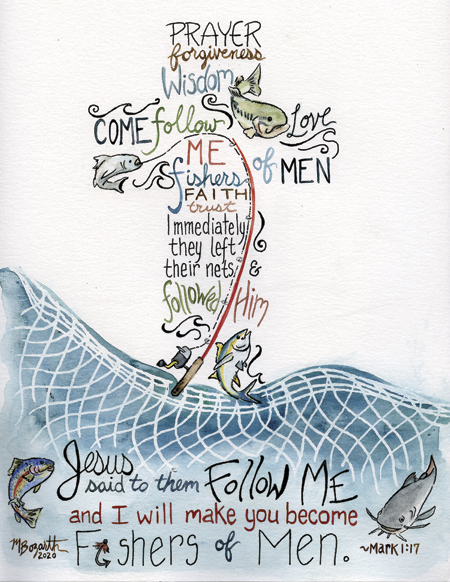
copyright 2020 Mollie Bozarth
My grandpa was a fisherman. Even today I was talking with a student, describing how he used to take Wheaties cereal and Cheez-it crackers, mash and dampen them into a malleable mixture, then pinch a bit onto the end of our hook. This was for blue-gill, and we’d be sitting there, excited but sleepy-eyed, having woken very early to join him on the quiet lake. I remember the soothing hum of a trolling motor. I remember early morning sun glinting on water, with trees and shoreline reflected upside down across the horizon. I remember casting and waiting and casting and waiting…and the excitement of the catch. Then that wriggly fish, which I was always too nervous to remove from my hook. It wasn’t until I caught catfish as a teenager (using chicken liver bait, because Cheez-its wouldn’t cut it) that I got up the gumption (wearing a glove) to remove the fish hook on my own. Didn’t really have a choice that day, because Grandpa was working and unable to join me for fishing. But he did strip and clean the catfish after I caught it. Grandma fried it, and we feasted that night.
What is it about fishermen that prompted Jesus to choose several as his close friends and disciples? Patience? Stubbornness? Dedication in long, odd hours? Ability to tell a story? Perhaps hope? Fishermen aren’t hopeful in an ignorant way. They know how to read the water, the weather, the season, the lake. But they are stubbornly hopeful and will sit endlessly, in anticipation of a catch. I confess, my excitement about joining Grandpa in an early-morning fishing trip always ebbed after an hour or so. He could have gone on long after we kids grew tired and grumpy. A true fisherman is out there for the love of the fishing, as well as the love of the fish.
I think that’s why Jesus chose so many fishermen: he needed people to go tell a good story – the good news/gospel; he needed men who were stubborn enough to see a mission through to the end, even unto death; he needed followers who were willing to hope in something unseen (something below the surface of the water per se), to wait in anticipation and walk by faith; and he desired followers who had a heart not only for the people they would “catch” but for the love of the “hunt” or mission itself.
All four gospels include this encounter between Jesus and his fisherman disciples (Matthew 4:18-22, Mark 1:16-20, Luke 5:2-11, John 21). Here is Luke’s account:
2 He saw at the water’s edge two boats, left there by the fishermen, who were washing their nets. 3 He got into one of the boats, the one belonging to Simon, and asked him to put out a little from shore. Then he sat down and taught the people from the boat. 4 When he had finished speaking, he said to Simon, “Put out into deep water, and let down the nets for a catch.” 5 Simon answered, “Master, we’ve worked hard all night and haven’t caught anything. But because you say so, I will let down the nets.” 6 When they had done so, they caught such a large number of fish that their nets began to break. 7 So they signaled their partners in the other boat to come and help them, and they came and filled both boats so full that they began to sink.
8 When Simon Peter saw this, he fell at Jesus’ knees and said, “Go away from me, Lord; I am a sinful man!” 9 For he and all his companions were astonished at the catch of fish they had taken, 10 and so were James and John, the sons of Zebedee, Simon’s partners. Then Jesus said to Simon, “Don’t be afraid; from now on you will fish for people.” 11 So they pulled their boats up on shore, left everything and followed him.
The artwork above was a commission from someone who wanted to give her pastor a gift. And, as I looked at artwork online related to “fishers of men,” I saw that websites often advertise this as a verse or passage for pastors. But Jesus wasn’t simply commissioning pastors when he called Peter, Andrew, James, and John. He was calling common laborers to come and join the Great Commission. Each of us – any average person who considers him or herself to be a follower of Christ – is called to “fish for people.” Part of this requires casting our net in faith – asking God to lead us into conversations with people He knows need to know Him. Part of it requires love of the mission – having a taste of heaven in our mouths that we can’t help but share with those around us. It requires story-telling – not “big fish” stories, but a simple sharing of our own story, our testimony as to how Christ and the gospel have affected (and continually affect) our personal lives. And it often requires stubborn, hopeful patience – because it may be years of praying and sharing/caring before we see faith take root in a friend or loved-one’s life.
One final thought: notice the phrasing, “Follow me, and I will make you become,” – in other words, Christ working in us, discipling, and training us is a process. We don’t need a PhD or MDiv in missions to share our faith with others. But we do need to be in relationship with the guy we’re following. If he is merely an acquaintance, not friend and Lord, then we’re not true fishermen. We’ll quickly end up tired and grumpy with no heart for the mission and no love for the fish.
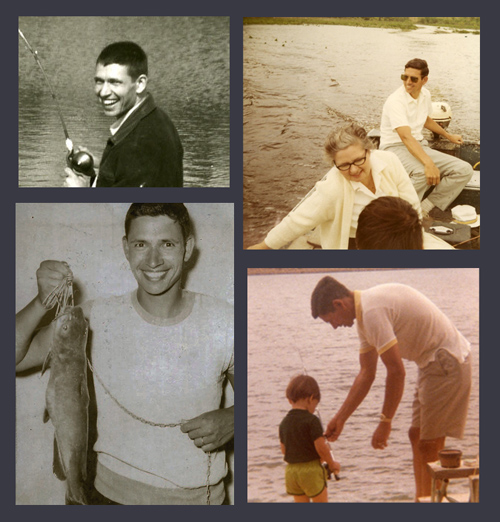
Rooted
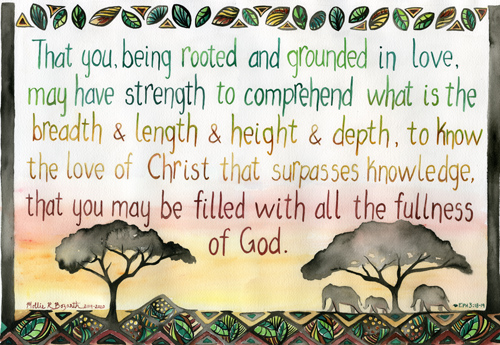
copyright 2020 by Mollie Bozarth
“Dwell,” “Family,” “Father,” “Rooted and Grounded in Love.”
Too often have I applied this verse to kids or people who come from loving, supportive families. And, yes, many of us are blessed to be grounded in that way – to be surrounded by people who love us unconditionally, giving us a firm foundation on which to grow and succeed. But what if 6 weeks in quarantine has been a time of mere survival, a wounding confirmation of fears and dysfunction that you long to escape?
Spring is a time of roots. Things that have lain sleeping, dormant, dead, begin to reach down and out and up. Impervious bulbs break open, sending radicles to drink up life-giving moisture. Sun streams through clouds, calling green to rise, stretch new limbs, blossom, and bear fruit.
If you are surrounded by brokenness and dysfunction (your own, or your family’s), you may feel more like the struggling weed in a cracked sidewalk than a flourishing plant with soil-bound roots. If that’s you, then I’d like to encourage you today with the truth that Ephesians 3 is about transplantation.
Paul speaks of his own transplantation and transformation early in the chapter. In verse 8, he says: “Although I am less than the least of all God’s chosen people, this grace was given me: to preach to the Gentiles the unsearchable riches of Christ.” This simple sentence is chock full of “outside, looking in.” Paul (aka, Saul) had been an outsider to the point of hunting down Christians as a young man. Followers of The Way were his prey until God grabbed hold of his heart, uprooted it, and planted in him a desire not only to live for Christ but to be willing to die so that others might know him as well. Gentiles also were considered outsiders. They were not part of the Jewish chosen family of God. Yet, Paul (a Jew) was sent to preach to Gentiles, inviting them to be grafted in, transplanted in, to the family of God.
Ephesians 3:14-21 states:
For this reason I kneel before the Father, from whom his whole family in heaven and on earth derives its name. I pray that out of his glorious riches he may strengthen you with power through his Spirit in your inner being, so that Christ may dwell in your hearts through faith. And I pray that you, being rooted and grounded in love, may have power, together with all the saints, to grasp how wide and long and high and deep is the love of Christ, and to know this love that surpasses knowledge – that you may be filled to the measure of all the fullness of God.
Now to him who is able to do immeasurably more than all we ask or imagine, according to his power that is at work within us, to him be glory in the church and in Christ Jesus throughout all generations, for ever and ever! Amen.
“Dwell,” “Family,” “Father,” “Rooted and Grounded in Love.”
“Family” – in Christ we are part of a new family, an expansive family reaching generations behind us and to generations to come. Our earthly families may seem cursed by sin, pain, even addictions that have been passed down the line. But, grafted into a new family, the old root is gone. We aren’t bound by the shackles of our forefathers. Jesus says in John 15:5, “I am the vine; you are the branches. If anyone abides in me, and I in him, he bears much fruit; apart from me you can do nothing.”
“Dwell” – abide, dwell, live – being rooted means that Christ is completely at home in our hearts, and we make our home in him. Being strengthened “with power through his Spirit in your inner being” (v. 16) is more than charging a rechargeable battery; it’s like a nuclear reactor in our inmost being where his “glorious riches” are a fathomless and ceaseless source of life-giving, renewable energy. As we dwell in him, our roots draw nutrients; if we are cut off from him, we become the limp plant, withered and lifeless.
“Father” – all humans have a father. Not all fathers are present. Not all fathers love or know how to love properly. But this new family we’re transplanted into has a very present Father. James 1:17 says, “Every good and perfect gift, every good thing given, is from above, coming down from the Father of the heavenly lights, who does not change like shifting shadows.” God doesn’t sit in an office far above us, detached and “swamped” with paperwork as he tries to deal with the messes of this world. He doesn’t have unreliable moods so that we never know where we are with Him or how to earn His favor. He does discipline us, as dearly loved children (Proverbs 3:12)…think of it like a gardener pruning branches so that even more can grow. But, like the verse in James states, God is ever present, giving GOOD gifts! And we can trust Him not to shift or change His character.
“Rooted and Grounded in Love” – so, your root has nothing to do with current circumstances. It has nothing to do with generations who came before you. Even if you are blessed with a stable earthly family, your root is not contingent on their stability. Your success and survival do not rely on your own strength, positivity, or determination. If you are rooted in Christ, you are grounded in a love that surpasses knowledge! What a thought! Only through his grace can we begin to comprehend how wide and long and high and deep is his love for us. But as our radicles reach down into fathomless soil, and our tendrils curl outward to cling to the vine, we begin to rise, stretch new limbs, blossom, and bear fruit.
As I was double-checking my vocab in writing this blog post, I read that if you brush your finger gently against the tendril of a vine, that tendril will turn and curl towards the direction of the touch. What an amazing snapshot of the Creator and his creation! God knows we need a gentle touch to turn and respond to his presence. And, just as any plant will lean towards the available sun, so we lean towards our Heavenly Father, eager for the warmth of his presence, ready to absorb the vitamin D we need to not simply survive but thrive.
When we are rooted in his love, fruit starts to show in our lives: love, joy, peace, patience, kindness, goodness, faithfulness, gentleness, and self-control (Galatians 5:22-23). I remember a random conversation with students this past year. I don’t remember the gist of the conversation or how the subject came up, but at some point I commented that joy comes from God. A young lady was standing across the room (probably washing out supplies at the end of class), and I’ll never forget the look on her face. Surprise; question; longing. “Joy comes from GOD?” she wanted to know. The thought had never occurred to her. My answer to her, and to readers here today was/is a resounding, “YES!!!” Hebrews 12:2 says, “Let us fix our eyes on Jesus, the author and perfecter of our faith, who for the JOY set before him endured the cross, scorning its shame, and is seated at the right hand of the throne of God.” Joy is such a deeper meaning than happiness. Happiness is something fleeting that depends on our feelings and circumstances. Joy can be experienced even in the worst of circumstances, even in the darkest of weeks. Just as Christ’s anticipation of joy enabled him to endure the cross, so can joy give us strength and hope for now and for the future.
I love Paul’s benediction at the end of the Ephesians passage (v. 20-21). “To him who is able to do immeasurably more than all we ask or imagine, according to his power that is at work in us…” Too often, I forget this truth. But I have tasted and experienced it many times in my own life! God is willing and able to do so much more than we could even think to ask. And his power (that nuclear reactor inside us) is beyond anything we can comprehend. Rooted in his love, we fill up and up ’til “filled with the fullness of God,” we begin to overflow. Then his grace spills over into the lives of others around us.
About the Artwork:
I always enjoy commissions because they force me to push past imagery or color schemes I would choose for myself. This commission was for a friend whose family emigrated from South Africa. The springboard for my design came from cloth patterns that would be found in that area. I wanted rich patterns with vibrant colors. Thus, in drawing, the first thing I did was to sketch out a border using patterns from the cloth. Next, I wanted traditional African trees. As it turns out, my friend grew up on a property full of Acacia trees. So, the choice suited well! I wanted the trees to root down into the patterns below. This is why I allowed the trunk of the tree on the left to break past the pattern edge and the border to bump up above the ground line. Lastly, I wanted a family of elephants. This wasn’t to make the design cliche’ “Africa.” The elephants were chosen partly because their daughter had been foolishly asked whether she had a pet elephant as a child (asked by ignorant American kids in her class at school). So, she used to joke about having a pet elephant…which of course she’d never had. Besides the inside joke, the elephants represent a family unit. And I have watched this family work so faithfully as a unit all the years I’ve known them.
The color scheme was dictated by decorations already in the room where they planned to hang the finished piece. The border was inked with a brush, allowing me to swirl and fade the ink, almost like watercolor. Then I started filling in greens, balancing them with yellows throughout the pattern. This organic method of design is often how my work develops. I’ll have a general idea in my head. But will start to place colors, and the idea in my head morphs and changes as I determine how to balance this color here with a little of that color over there. By the time I’d finished the border, I knew I wanted a subtle glow of sunset in the sky behind the trees and elephants. However, it had to be a soft glow and subtle fade so that the lettering/words would remain a focal point. I had originally thought to do all the lettering in crimson. But, as things progressed, I preferred a transition from green to gold to reds. This ombre’ fade gave depth and movement to the words, which could look blocky and boring if all done in the same color, same value. The color fade is also a subliminal message. The lettering starts as green (like growing plants), then fades to ochre yellows (as dust of earth), and deepens to a russet brown (roots) so that the words themselves feel rooted and heavier in the final line than in the upper lines of text. Ah! The fun of being an illustrator!
This is the longest blog post I’ve typed out in a very long while. I feel I should place a check-box (as my students used to do to when writing long papers) and say, “check here if you actually read this far!” Instead, I’ll just say, “Thanks for reading!” and we’ll leave it at that.
Oak St. Treehouse – illustration process

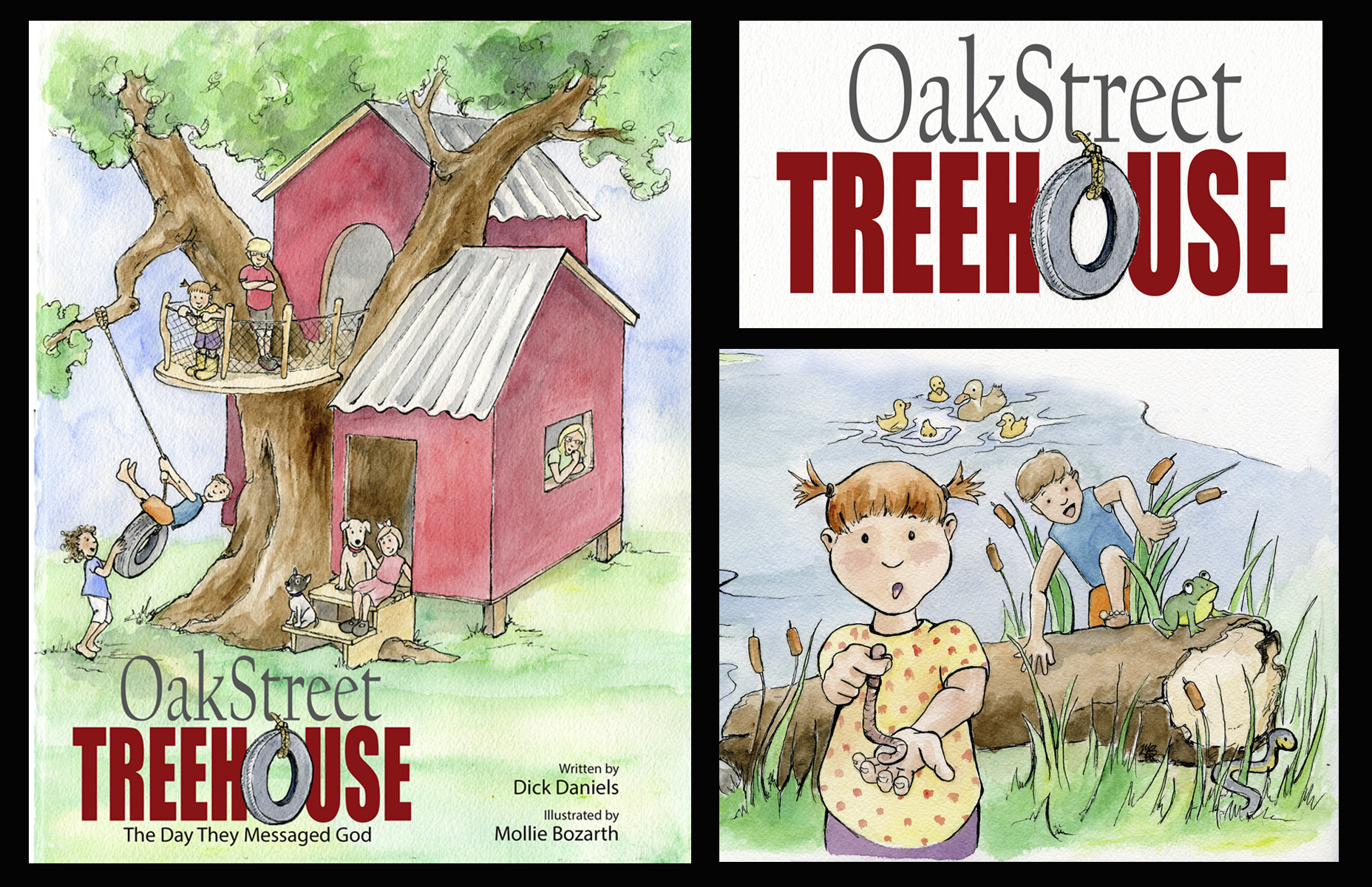
copyright 2019 Mollie Bozarth
As many of you know, a book I illustrated went into publication in February of 2019. It was recently given a Bronze Medal by Illumination Book Awards. You can click HERE to see their site. It’s also up for a Christian Indie Award. You can click HERE and vote for it now through March! (Have to scroll way down to the Children’s Age 4-8 category on that site.)
But today’s blog post is really about the illustration process. I thought it might be fun for you all to see how an illustration progresses from idea to published. When I receive a manuscript, the book has been paced out and divided into 17 layouts. The first and last pages are single-page spreads. The rest are double-page spreads (meaning the illustration spans both the left and right pages as you’re reading). The manuscript has text and a few notes of what the author would like to see in the illustration. However, as an illustrator I have a lot of freedom to use my imagination! For this book, it was fun to imagine and design an entire treehouse space. I knew I wanted it to have a crow’s nest, where kids could climb up and look down on the world. I knew it had to have a tire swing. And there had to be enough space inside the treehouse to fit 6 kids. It had to be built around an Oak Tree. Personally, I love the sound of rain on a tin roof. So, I designed a simple corrugated metal roof. Some manuscript notes were very specific. For the page I’ll walk you through, the notes were simple: Picture of them in the backyard. Be sure to include all the things they see.
Here is where I go to work! The first thing I do when planning a scene is to think about the personalities of each character. The boy who likes to climb things will be on top of his favorite boulder with the feisty little dog excitedly barking up at him. The gentle girl who loves to draw will be smelling flowers. The older girl, who finds a spider web, must be in a position where she could/would see spiders. The boy who found a stick (I decide) will be drawing with it in the dirt. The competitive girl will be hanging off the tire swing. And the littlest one will be cradled in the hole of the tire swing.
Next comes reference images. For a cartoon style book, I won’t necessarily photograph models. So, I gather inspiration imagery from online and base my sketches on the gathered images. Here are sample images from page 22-23.

Now, I sketch! Sketching layouts is the most time-consuming part of my job. I’ll make quick thumbnail sketches to plan basic size and position of characters. Then I tape two pieces of printer paper together and sketch, erase, fix, adjust until proportions, poses, and perspective all work. If I like most of a layout but decide to change one character, I’ll draw the new pose on a separate sheet of paper. Then I’ll Frankenstein the new pose into the layout. Frankensteining is a time-saving trick illustrators use. It can be done by cutting and taping the new item onto your sketch. With Photoshop I can also do it digitally, scanning the original drawing, then scanning the new pose and fitting it into the scene. For page 22-23, I changed the boy drawing with a stick, the size of the lilac bush, and sizes of characters in the background before I reached this final design.
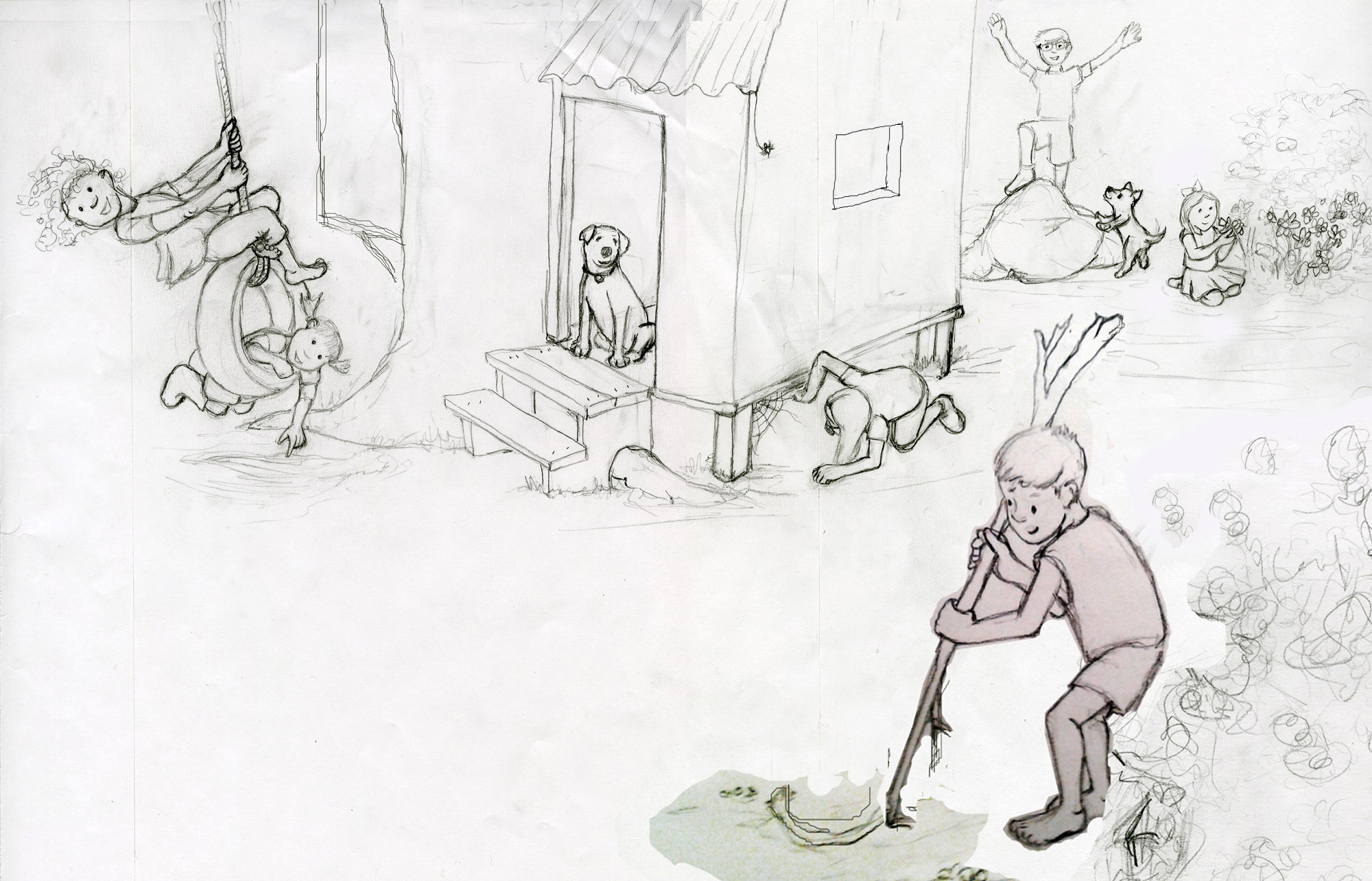
When designing a 2-page spread like the one above, I must keep in mind the gutter. Gutter is an area of dead space in the middle of the layout where book binding will divide the illustration in half. For the illustration above, I made sure that a spider swinging from the corner of the tin roof, and the edge of “C” drawn in the dirt, weren’t going to be swallowed up by the gutter. I also must plan space for the type, any words or dialogue that will be on the page. For this illustration, empty space in the grass will hold all text. Once layouts are approved by an art director (or author), it’s finally time to paint! I print out a small (3×5-ish) copy of the layout, place it in my projector, and enlarge it up onto watercolor paper to trace the design. At this stage, I may still tweak shapes of arms, shoulders, or facial expressions.
The refined drawing is inked with either ink and brush or a Uni-ball Vision waterproof pen. I’ll work several illustrations at a time. While one is drying, I ink another. Finally, I paint, filling in grass for several scenes, sky, tree bark, shirts, skin tones, etc. I have to make sure details stay consistent throughout all scenes. So, I pay close attention to patterns in shirts, details in the game board, fur color of dogs, hair styles. If I finish an illustration and realize some major detail needs changed, I’ll ink and paint the character onto a separate sheet of watercolor paper, scan it, and Frankenstein it into the final illustration with Photoshop. When all illustrations are finished and approved, it’s time to publish a book! Here is the completed artwork for page 22-23.
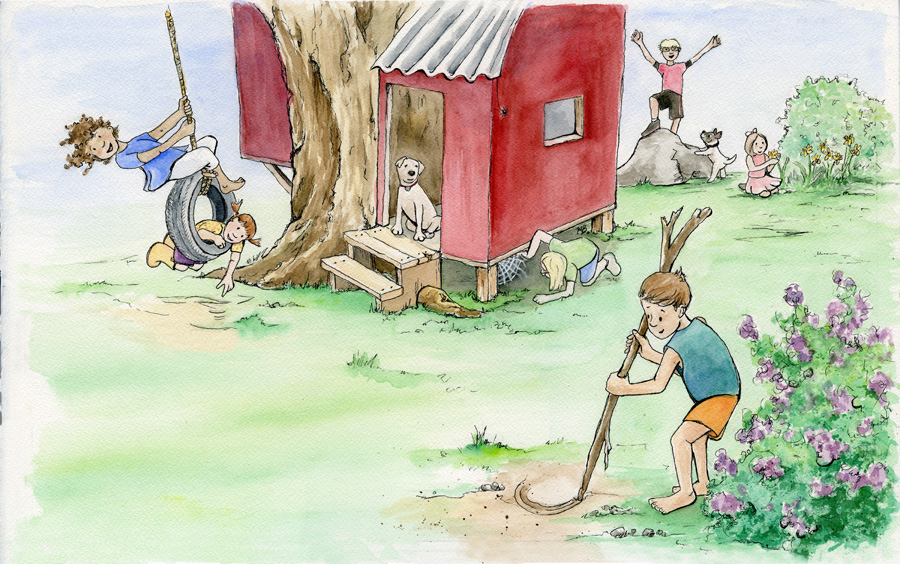
copyright 2019 Mollie Bozarth
And, here is a screen shot of the page with text!
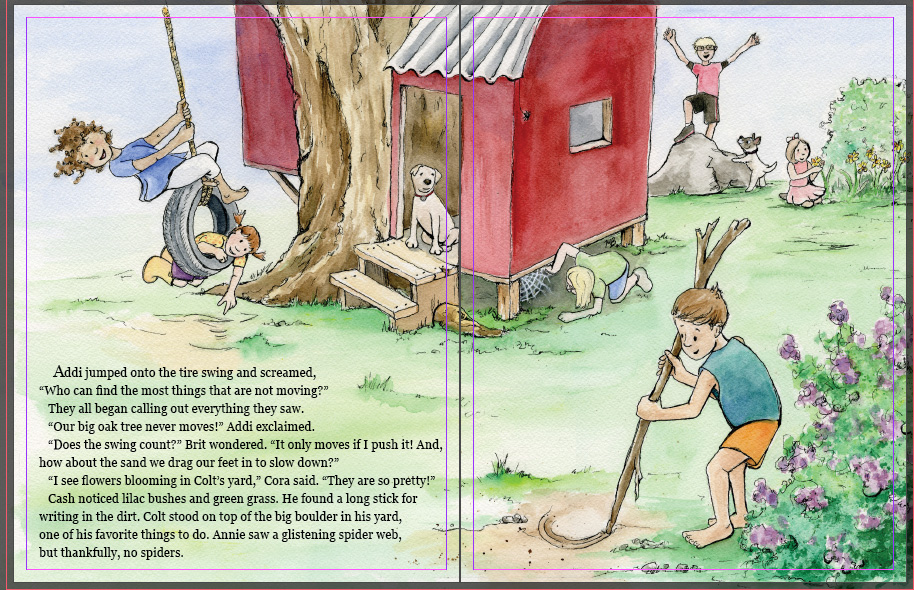
text copyright 2019 Dick Daniels
Well, I hope you enjoyed your walk through the illustration process. It’s a lot of work! But the finished product is rewarding. And the creative aspect of designing a world and its characters is fun. If you’d like to read Oak Street Treehouse, you can purchase a copy HERE on Amazon.com. Or you can request that your local library buy a copy, and check it out there!
Every Hour
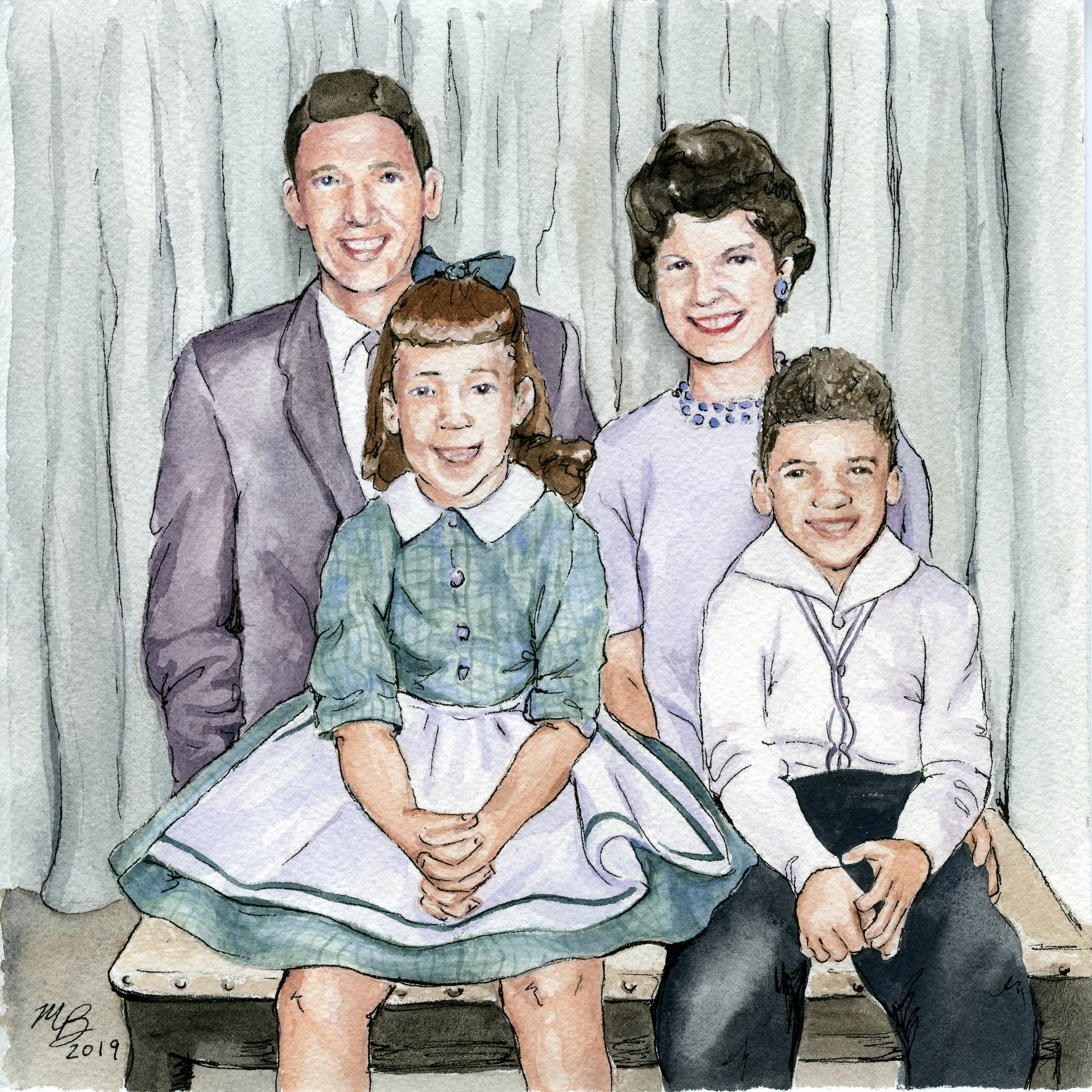
copyright 2019 Mollie Bozarth
As many of my readers know, we moved my grandma up from Virginia and into my house just a few short weeks before she passed away. Those weeks were tough, but not for the reasons I expected. I felt that helping take care of an elderly woman dealing with severe physical pain and slight dementia brought out the worst in me. I’m a problem-solver by nature. I couldn’t take away the pain. And I couldn’t talk her into a calm state if she got flustered about papers she thought she’d misplaced or pills she was keeping track of. The hospice care worker and my mom were excellent in these situations. But I’d end up impatiently giving up and heading to bed, trying to guard my sanity for the next day’s work. That being said, I wouldn’t have traded the few weeks she was here for anything. It gave my nieces, nephews and siblings a chance to really spend time with Grandma before she passed away. My brother and his little girls would pop over as often as they were able. And we all had a perfect family weekend with her over Labor Day, just before she took a turn for the worse.
One of my favorite memories of Grandma’s time here was a simple car ride. We were driving to my mom’s house, and I had the radio turned to WBGL. The song Lord, I Need You by Matt Maher came on. This is one of my grandma’s (and frankly one of my) favorite worship songs. She started singing softly. I joined in. I can remember exactly what light we were sitting at, waiting to cross the highway and turn into Mom’s subdivision. The lyrics say, “Teach my song to rise to you when temptation comes my way. When I cannot stand I’ll fall on you. Jesus, you’re my hope and stay. I need you, oh I need you. Every hour I need you. My one defense, my righteousness. Oh, God, how I need you.” We both knew she would be headed home to Heaven soon. But we got to share a moment of heaven on earth there in the car. And what a humbling and peaceful moment it was. To sit next to a woman I loved and admired…my prayer warrior grandmother…and simply worship together. In the midst of all her pain, she knew Whose arms to fall into. She embraced her need of Him above all else.
This painting was completed for my mom as a Christmas gift. I chose the scene because it’s her entire family…all of whom are gone now. But it’s them at a time long ago when life was simple and childhood safe. The photo was taken about a year before Mom’s parents and grandparents became Christians. They did not know their need for Christ when this snapshot took place. Yet, in spite of the happy family and safe, stable life, something in them realized that there could be more. Their faith would create a domino-effect on generations to come. And that same faith would carry them through deep deep waters, family struggles, illnesses that only God knew were coming. I am so glad that nearly 60 years after this photo was taken, right up to the final moments of her life, my grandma continued to love God with her whole heart. Every hour, we need Him. Every hour, He is faithful. May I (and all of us) hold tightly to that truth as we head into 2020.
Portraits of Scotland – Bookseller
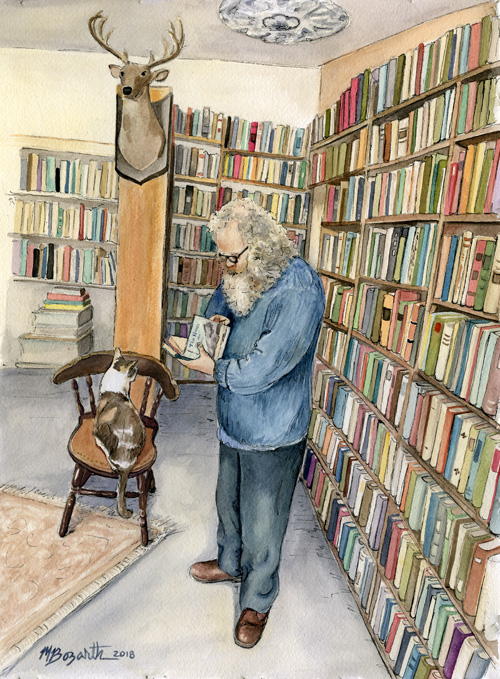
copyright 2018 Mollie Bozarth
Wow! It’s been so long since I’ve had time to sit and blog…not that artwork hasn’t been produced in the past several months. I finished illustrations for a children’s book this past summer. That book is in print now! The children’s book is a blog post for a different day, but a love of books is what led me to illustrate in the first place. And a love of books is the jumping-off point for today’s blog.
I recently heard about some gal who’s made herself famous by telling people to: “hug every item in your house. If it doesn’t bring you joy, then get rid of it.” Apparently, she’s inspiring people to declutter their homes. Don’t know her name, and frankly don’t care who she is because I also heard that this same gal thinks you should get rid of all your books…except maybe your favorite 15. Obviously, this lady isn’t a reader. Perhaps she’s never read a book in her life. She needs help, and I pity her deprived existence.
The bookshops of Scotland were some of my mom’s and my favorite memories of the trip! We’d hunt for them in every place we visited. Some were hard to find, tucked next to a road on a barren hillside with a sign out front to catch the eye of people driving by. Some were merely corners in a village historical museum or church. Others were jammed into rows of bookstores on Edinburgh lanes or peppered amongst other shops along a town’s main street. One in Inverness filled an entire church building, complete with vaulted ceilings, a wood-burning stove, stained glass windows, and a wrought-iron spiral staircase! Each was unique. And each bookseller was as unique as his/her shop.
There was a dapper older gentleman in Edinburgh who sat behind a tall desk, dressed in tie and tweed sport coat. There was a chatty gentleman in a roadside bookstore who regaled his guests with coffee, tea and scones. Then we stepped into King’s Bookshop, in the village of Callander. What a gem of a shop! It’s a cozy space, complete with cat, stag’s head, and decorative medallion on the ceiling. This bookseller seemed shy. He was happy to help us find the authors we were looking for. And, thankfully, he was willing to pose for a few photos so that I could piece together this portrait/illustration! It seemed that the garden (hidden behind his shop) was his sanctuary. He would fade away, back to the garden whenever he felt he wasn’t needed in the main shop.
This portrait is a common example of me hating to paint patterns…and realizing partway through the illustration that endless rows of books are an organic pattern. Needless to say, I don’t plan on painting books again any time soon. But the tedious task was worth it for this particular portrait. Lines of hand-built shelves frame the central figure. Colorful spines create almost a white-noise backdrop for the quiet man in the peaceful shop. Cat’s tail hangs down like a poised pendulum on a clock, as time barely matters in a place like Callander. The stag’s head and ceiling medallion speak of tradition, adding a regal touch to a simple bookstore on a typical village street. The bookseller’s focus, fittingly, is on a book. My goal with this illustration was to make it feel as though the viewer had just stepped off the street and into a candid, common moment. If you visit the King’s Bookshop some time soon, perhaps you’ll see just that.
Run the Race
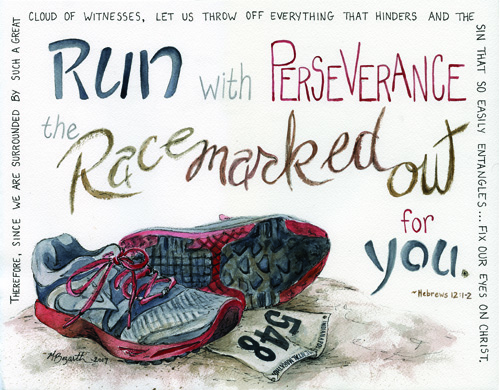
copyright 2017 Mollie Bozarth
I am not a runner. In order to get me to run, you have to put a basketball in my hands or a soccer ball at my feet. Then I’ll clock miles up and down court (or the field) without realizing that I’m actually running.
But I know plenty of runners – have cheered on students as they pace through cross-country and track meets; have cheered friends while they push to the finish line in the Chicago marathon; have graciously/carefully avoided hitting runners with my car when die-hards are jogging along our local highways. In my vast experience of watching other people run, here’s what I’ve observed about true runners:
- they’re in the race to pursue their own best time
- it’s often more about finishing the race than winning it
- something in them loves to run and finds the discipline invigorating
- they strip down to the essentials, neither carrying nor wearing anything that drags them down
- true runners don’t cut corners or cheat the race marked out for them
- their focus is forward – not looking back, or stopping to gaze around them, nor looking down
- when a race gets tough, crowds cheering from the sidelines can give the boost needed to persevere to the end
- worn out running shoes can be a trophy in themselves, proof of miles well-run
I’ve no idea whether the writer of Hebrews was a runner. But he must have understood something about the discipline, because his analogy 2,000 years ago is still spot-on today. As Christians, we are called to be true runners, to never give up on the race marked out for us. Whether the path God takes us through is desert, rocky terrain, green pastures, or narrow valleys, He’s placed markers along the way to keep us on track. Often times, these are the guidelines laid out in His Word. They may also be the convicting prodding of the Holy Spirit or words of affirmation and/or correction and accountability from family and friends. In the verses following (Hebrews 12:6), the writer quotes Proverbs 3:11,12 saying: “do not lose heart when He rebukes you, because the Lord disciplines those He loves.” In other words, the race markers and corrections we encounter aren’t meant to frustrate or depress us, nor are they meant to be ignored. They are there because we are loved by the God who sees a bigger landscape than we can comprehend…a God who desires to guide us around pitfalls more dangerous than we’d realize.
When I first read Hebrews 12, I pictured familiar faces of friends as the “cloud of witnesses” cheering me on. Those faces certainly are part of the crowd. However, the first verse actually starts with “Therefore” – pointing back to chapter 11, which recounts the lives of several Old Testament men and women. It’s generation upon generation of people who lived by faith and persevered to the end of their race. We aren’t simply cheered on by people like me (people who don’t mind watching a good race but prefer to avoid running whenever possible). We’re cheered on by thousands who endured muscle cramps and shin splints, yet refused to give up. Why did they refuse to give up?…was it sheer stubborn determination, or foolish pride that kept them going? The first verse of chapter 11 tells us why: they refused to give up because they were “sure of what they hoped for and certain of what they could not see.” Having reached their finish-line and found more joy than they could have imagined, they now cheer us on. With those voices shouting encouragement, we can be inspired to strip off everything that slows us down, and keep our eyes on Christ. We can let go of baggage from our past, not looking back. We can ignore temptations around us, not stopping to gaze at the world’s distractions or leave the path to roam “greener pastures”. We can look up at the Son who ran his own race and came out victorious, instead of gazing down at gravel beneath our feet.
Today’s painting was inspired by a young man (Joel) who loves to run. I had the privilege of being one of his middle-school youth leaders many years ago. Then, as he grew up and headed off to college, he came back as a volunteer leader for the same youth group he’d grown up in. Now the race marked out is taking him in an unexpected direction. Feeling a prodding to leave the corporate world, he has started to apply for youth ministry positions. While this is a career shift, it’s not one that surprises those who know him. His knack for teaching, heart for ministry, and rapport with students have been evident for many years. One of the most memorable lessons Joel taught on a Sunday evening included his running shoes. Holding up a pair of worn out sneakers, he told us about all the miles he’d spent talking to God, worshipping, asking questions, listening…just being in relationship with his Heavenly Father. I’ve seen so many of our kids look up to Joel. They see his steady obedience, sense of humor, love and honor. They hear his honesty about ups and downs, struggles and faith and the overwhelming faithfulness of God. Joel doesn’t simply “talk the talk;” he runs the race. And, he’s one of the cloud of witnesses cheering on other runners, saying: “Don’t give up! Keep your eyes on Christ!” I pray he continues to run his race with perseverance, all the way to the finish line. And, I hope he always hears others’ voices around him, encouraging him to look up and finish strong.
Anya – The Scent of Home
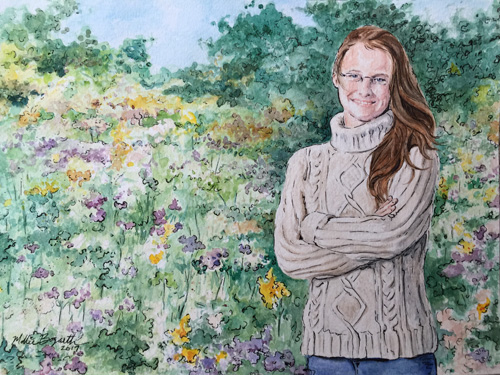
copyright 2017 Mollie Bozarth
The “scent of home” – if I were to ask you what that means to you, what would you say? I’m not talking about the Febreze commercials where your son’s room smells like a gym locker. This is more along the lines of a scene in Disney’s Ratatouille where the food critic flashes back to a moment in childhood, sitting at a rustic kitchen table where someone who loves him has prepared a meal for him. Each of us have experienced moments like that, where a sight or scent triggers memories of a time and place that once was home. For me it can be fresh sawdust, taking me back to hours spent in my dad’s workshop, sawing and hammering as a child. Or, a salty sea breeze, and I’m suddenly 7 years old again, building castles and burying jellyfish in wet sand by the Atlantic Ocean. Certain soaps remind me of my grandmother’s house and of her hug. Home. For some, “home” is about the people around you. For others, it’s a place or country where you were raised or spent years of your life. I’ve heard that missionary kids, military families, and others who moved several times growing up may struggle to pinpoint a particular place they’d call “home.” Yet we all have an idea of what home is or could or should be.
Today’s portrait is based on a senior photo-shoot I did several years ago. When I talked with Anya about what setting she’d like for her photos, she mentioned a prairie preserve nearby. She said the prairie paths and flowers reminded her of the Ukraine where she grew up. Anya is an American citizen now. So, in most ways, America is home now. But yellow and blue is woven into the fabric of her character, her values, her family’s cultural heritage. If you look up the meaning behind the Ukrainian flag, you find that yellow represents fields of wheat, and the blue symbolizes sky, mountains, and streams. No surprise then that nature, fields of wild flowers, and fresh air are the “scent of home” for Anya.
C.S. Lewis talks about the common human longing for our own “far-off country.” In The Weight of Glory (Oxford, 1942) he says, “These things – the beauty, the memory of our own past – are good images of what we really desire…but they are not the thing itself; they are only the scent of a flower we have not found, the echo of a tune we have not heard, news from a country we have never visited.” He goes on to comment about philosophies that try to “convince you that earth is your home…by trying to persuade you that earth can be made into heaven, thus giving a sop to your sense of exile in earth as it is.” But, he continues, “we remain conscious of a desire which no natural happiness will satisfy.”
For myself, I can attest to a feeling that the sense of “home” I long for is elusive. Were I to return to my 7-year-old self at the beach, would I really savor the sun on my face and the salty taste on my tongue? Or would I more likely be squabbling with my brother about who gets to use the shovel next, and nervous about jellyfish stings when I do dive into the waves? Time has a way of filtering our memories. Like a soft-focus lens, it blurs the edges, emphasizing what we want, need, long for and deemphasizing other details. According to Lewis, “home” is elusive, not because it never existed, but because our desire points us to a home we haven’t visited yet…a “splendor, which nature fitfully reflects.”
Anya is someone I’m blessed to know, because she and her family live out their faith. And, in living out that faith, they remind me of “home.” When we’re goofy and laughing and joyful, it’s a taste of joy that will one day become eternal reality. When we’re talking about the ups and downs of life, they keep me grounded in the truth that there is more to this world than what I see with my eyes. When we’re introducing one another to foods from the other’s culture, it’s a tidbit, a sampling of the coming feast in a country we haven’t yet visited. When we’re shooting photos in a field of wildflowers, the colors and scents surrounding us are merely a ghosting of the flower we have not found…the aroma of a home yet to come.
Siblings
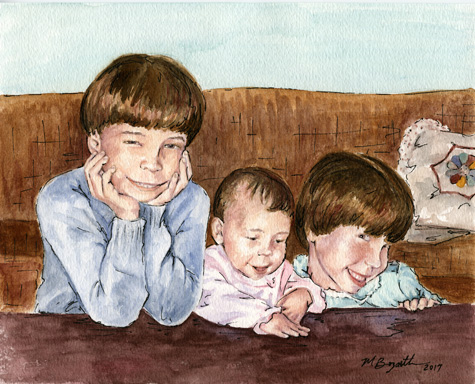
copyright 2017 Mollie Bozarth
It’s been way too long since I’ve had a chance to post…not that I haven’t been painting! But May was taken up with sample paintings for a possible book project, school finishing, and diving straight into curriculum writing for a chunk of June. So, I’m just now getting back into a more regular rhythm with time for blog and personal projects.
The painting above is me (the cute one in the middle) with my two older siblings, a portrait painted recently for my sister’s birthday. Looking back at old family photos is such a funny time-warp. The hair styles, couch and pillow scream “late 70’s/early 80’s” – in fact, my sister wondered why I didn’t update her hairstyle when painting the portrait. But the Mary Lou Retton haircut was in then, so I’m sure Jenny looked stylish for the time. I can’t see much (if any) of current me in the baby version here. However, seeing my siblings at those ages reminds me of my nieces and nephews now. We have photos of Jenny’s daughters with that exact sideways glance, tilted head, coy expression on their faces. And any photo of Jeremy looks identical to his eldest boy. I could even venture to say that my youngest niece resembles my baby photos, with her round cheeks, turned-up nose, and dark hair falling across the top of her head. The Bozarth genes run strong.
Working on this portrait brought back a lot of childhood memories. Jenny braiding my hair, while I sat and whined that she was pulling too hard. Jeremy teaching me how to pace my steps for a hook shot in basketball, or letting me try out his juggling equipment and showing me how to juggle various items. Jeremy instigating trouble and then sitting back to watch us younger siblings squabble it out. Jenny letting me troop along with her and her friend Laura in the woods behind Laura’s house…showing me how to suck the sweet nectar from honeysuckle flowers, and consoling me when I screamed as a snake slithered around my feet on the forest path. Years of sharing a room with Jenny, and her recounting of my random sayings when I’d talk in my sleep. Asking Jeremy for help with math or science homework, and trying to listen as he’d explain 5 different ways of solving the problem when I really just wanted 1 easy answer.
Any of you who know me well probably hear me talk about my siblings on a regular basis. They crop up naturally in conversation because they continue to be part of every-day life. Making time to hang out with my brothers and sister isn’t as easy as it was when we were kids. Of course, sharing a room or being packed shoulder to shoulder in a car for 17 hours was never thought of as quality time. However, those forced situations of time together helped build the foundation for our relationships now. Living within 40 minutes of each other, it’s easy to let months slip by where we’re each consumed with our own fast-paced schedule. We have to be purposeful in calling and connecting. I realize I’m blessed to have siblings I still want to know and spend time with. And, though I don’t necessarily learn from them as I did when little, I do still look up to them in many ways. They’ve taught me about life and marriage, parenting, faith, work-ethic, budgeting, priorities, and family. Some of those lessons currently apply in my life; others I may use down the road. Besides the serious stuff, my siblings are also fun to be around! If you ask any of my nieces and nephews, they’d probably tell you that we can be pretty goofy when hanging out together – perhaps it’s because spending time together takes us right back to childhood, bringing out our silly sides. We let go the stresses of our adult responsibilities and take a few moments to flash back to when we were the kids in those photos.
If you have siblings, take some time to look back and remember who you were. Then, take a look now and see who you are. If those relationships aren’t what you’d like them to be, you can’t necessarily change who you’ve all become. But you can always work toward restoration, reaching out when and how you’re able. And, if you’re on the cusp of adult-hood, waiting for the chance to get far away from your siblings, pause before you run. Remember the good times when possible, forgive the hurts (with God’s help…not something you can do on your own), and be open to staying connected in the years to come.
Portraits of Scotland – Tobermory Fisherman
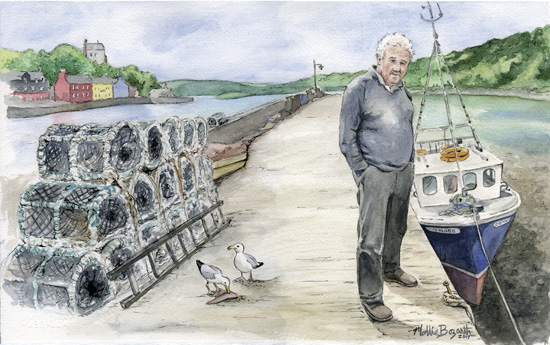
copyright 2017 Mollie Bozarth
I’m finally back with another in the Portraits of Scotland series! While in Scotland, we spent several weeks on isles, with the sea visible or within easy drive of where we stayed. Tobermory, on the Isle of Mull, was no exception. We stayed in Harbour Guest House on Tobermory High Street, which is the main street that curves around, hugging Tobermory harbour. Tobermory is the capital of Mull because, with a population of 700, it’s one of the few places large enough to be considered a town rather than a village. You may remember mention of it in my post about the Leather Artisan. Well, having spent so much time around the sea, and having eaten fish and chips to our heart’s delight, I hoped to find a fisherman who would let me paint his portrait.
Our very last day on Mull (even as we were packed up and ready to drive back to the mainland), I stopped in at a shop to pick up a glass fusing piece I’d made the day before. When I came back to the car, my mom said, “Mollie, weren’t you hoping to paint a fisherman? I’ve been watching this man climb nimbly down a narrow metal ladder to his boat. I can’t believe his agility! He must be nearly 70, but he’s up and down that ladder in the blink of an eye! This is your chance! Ask him whether he’d mind if you take his photograph.” So, I approached the fisherman. It was a quiet morning, still fairly early, and he was alone – no crew with him. I figured he had simply been checking on something in the boat, and I was right. Funnily enough, his first response when I asked about taking his photo was, “Does my hair look alright?” This is the same question Alan (the Leather Artisan) asked before I photographed him!…must be a Tobermory thing. Well, the fisherman’s white hair was blowing in a harbour breeze, so I laughed and said it looked fine. Like several of the people I approached, he was surprised anyone would want to paint his portrait. Perhaps the tourist-painter intrigued him. Perhaps he was merely complying with an odd request. Whatever the motivation, he agreed. And, while I took a few photos, we chatted.
I asked about his work. We’d eaten fresh lobster the night before. Had he caught those lobsters? He said that all of the lobsters his crew catch are actually shipped overseas…makes more money than selling it locally. I asked whether he had children who’ve followed in his footsteps career-wise. He said he has no sons. But his two daughters married fishermen, and his sons-in-law work with him. It was a short conversation, a brief glance into his life. But each of these portraits has opened doors for me to learn something of the people of Scotland. They are humble, yet proud; hospitable and friendly; they work hard and value tradition; they highly value family and community. Possibly because their towns and villages are so small, a sense of community is inevitible…for better or worse, everyone seems to know everyone else. I asked whether he knew Alan, and he said, “Aye, of course! I know him well.” My favorite part of this particular portrait is the fisherman’s stance. Hands are jammed solidly into his pockets. Weatherbeaten and ruddy, his face holds the wrinkles of sunshine and wind, laughter and life. His eyes are used to peering out across the water, whether through glaring sun, storm, or fog. No fancy airs or moment taken to brush his hair…the wind would blow it again anyway. He is a man’s man, a working man, a provider for his family, comfortable in his own skin. The stance says, “Here I am! If you want to paint a portrait, you’re welcome. Just make sure my boat is included. For my boat is part of who I am.”
This illustration is actually a compilation of several photos taken during our days on Mull. The jetty where the fisherman stood was lined with lobster cages. Beyond those you could see the panoramic view of iconic Tobermory shops. The red, yellow, and blue group of shops in particular is well-known. Apparently, they appear in a BBC children’s show called Balamory. I’m a little old to watch the show now, but the Scottish accents are fun! In designing this scene, I took the photo of the fisherman with his boat, combined it with photos of the panorama and lobster cages, then added in a couple seagulls for good measure. Huge seagulls are the other “fishermen” of Tobermory. Whether swooping and diving below the water’s crest, or scavenging bits of fish left by the pros, they’re always interested in the day’s catch. Just a few feet from this scene (kind of behind and to the left) was the fresh fish-&-chips vendor. This tiny trailer sold fish that had been caught fresh that morning. You’d tell them what kind of fish you wanted (halibut, cod, etc.), they’d pull it out of the fridge, dip it in batter, and fry it right there in front of you. Then they’d toss it onto a bed of hot chips, and you could add vinegar or ketchup before carrying your treasure home to feast. It was so good, Mom and I literally ate there 3 out of 4 nights on Mull! If you look above the Tobermory shops, you’ll see one more iconic building. The Western Isles Hotel, up on the hill, is one of the filming locations for the 1945 Wendy Hiller movie, I Know Where I’m Going. Wonderful film! If you’ve never seen it, check it out!
Well, this concludes our tour of Tobermory. Of all the places we visited, this is a top one on my list to visit again. If you’re ever there yourself, keep an eye out for my friend Alan and for his neighbor, the fisherman.
Puppy Love
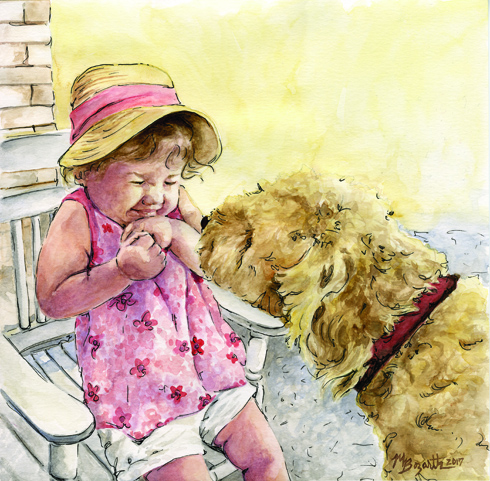
copyright 2017 Mollie Bozarth
I remember the day we got our first family dog. I was 6 and my younger brother was 4. We drove up to my grandparents’ house in Virginia, and as we piled out of the station wagon, a Golden Retriever bounded up to greet us. This was not my grandparents’ dog. They lived in the country, and this retriever liked to break away from his owners and come hang out at my grandpa’s place. Grandpa is a dog person in that all dogs love and respect him…and many strays have found their way to him over the years. The dog’s name was Beauregard (a proper southern name, but way too fancy for the countryside). Everyone called him “Bo-jack” or “Bo.” Golden Retrievers are one of the most family friendly breeds, and Bo lived up to that. We fell in love with him at once (including Jonathan, who had always cried or been scared around dogs in the past). When asked where he came from, Grandpa told us that Bo belonged to a farm nearby. The farmer had several dogs, most of them very aggressive. Being gentle, Bo didn’t like the other dogs. So, he’d break free every chance he got, and would come to visit Grandpa’s house.
Needless to say, we begged our dad to let us keep him. Bo obviously didn’t like his home. Maybe the farmer would sell him! Better than that, the owner actually GAVE the dog to us, saying he was too much trouble to keep since he ran away all the time. With Bo now part of the family, we took a long walk while discussing a new name for him. My older brother, Jeremy, said, “He looks like a lion with that orange mane of fur around his collar. What if we name him ‘Aslan’ like the lion in the Chronicles of Narnia?” So, Aslan he became!
Aslan was my puppy love as a child. Childhood memories are full of him: building a fence on a muddy/rainy day to give him a safe area in our backyard; plucking slugs off of his dogfood bowl before feeding him each evening; being dragged down the street when he’d practically pull us off our feet on a walk; tennis balls chomped in half that would get caught on low tree branches when we tried to toss them for him; Aslan digging holes in the yard to lay in the cool dirt on a summer afternoon; and (best of all) the retriever tendency to lay his head on your foot so that he knew you were close by. I wouldn’t trade those memories (even possibly the gross slug memories) for anything.
Today’s illustration is from a candid moment of my niece with my Golden Doodle, Jack. Jack leaned in to sniff her, and her hands went instinctively up under her chin, with an expression of pure glee on her face. I can’t believe we caught that on camera! The photo has been hanging next to my desk at work for several months. When I saw that the SCBWI drawing prompt for February was love, I thought, “What a perfect chance to paint that portrait!” I also happened to need a portrait to demo for my Painting 2 class. So, timing worked out well. My niece has known Jack her entire life. His name was one of her first words. And, when she and I took Jack for a walk yesterday, she enjoyed repeating his name at an obnoxious volume all the way down my street (she’s 2, so she can pull off “loud and repetitive” without driving the neighbors crazy). She tried to “help” me walk him by holding part of his leash. Like Aslan, Jack likes to pull hard on a walk. I made sure that her attempts to “help” didn’t get her pulled off her feet.
Watercolor Portrait Tips: when demonstrating to my painting class, I reiterated several tips that any of my “old” students reading this will recognize. 1. White paint is a “no-no” in my classroom. Watercolor paper is white. Simply leave the white paper where you want highlights or bright whites. Do not mix white with red to make pink. Instead, water down the red to let more of the white paper show through…thus, pink. 2. Most white areas aren’t a pure white. Example: the shorts and the chair. For the shorts and chair, I mixed a cream or a pale grey, building up subtle shadows. 3. Shadows in skin should be blue-violet or red-violet. Using too much brown in skin shadows makes the skin tone look cold or lifeless. Think of the red blood flowing through our veins…there should be a pink tone, even in the shadows. My student had a good question: “What if the person you’re painting is brown or black skin tone?” Well, still use a peachy pink or pale yellow for the lightest highlights. Then mix red-violet and blue-violet with your browns in the midtones and shadows. 4. Textures like dog fur should be done by layering different tones, creating a haphazard pattern of fur and shadow shapes. You still need to pay attention to the bone structure and the way the light hits the body (even if he looks like a ball of fur). Several layers of small strokes, following the direction and flow of the fur, will give the desired effect. 5. It’s always about contrast. Darken tones behind lighter objects to help the lighter object stand out. 6. The pen & ink (if used) should highlight lines and details you want to accentuate or tighten. But I’d stay away from a full outline in ink. Particularly, facial features and highlighted fur should have very little ink added. Too much ink, or too solid an outline, can make soft features look harsh. The way my masters’ profs put it: “Either the ink or the watercolor should take center-stage. Fun ink outline with very basic color washes. Or, detailed watercolor with very little ink.” 7. Last but not least: do not be a slave to your reference! In this illustration, I eliminated several distracting objects from the background. I also changed the colors in her shirt and hat to better match the room where this will hang. Use artistic license to decide what to keep and what to tweak, change, or eliminate from your reference image.
for Alex
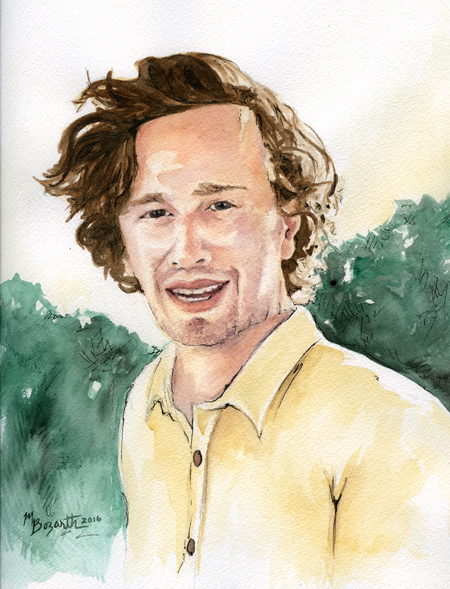
copyright 2016 Mollie Bozarth
How do we process grief? With words? In silence? With anger, action, inactivity? At some point these have all applied to me. Sometimes…I process grief through painting.
As a teacher, there have been times where people asked me what I dislike about my job. I may flippantly reply that I hate when students are lazy, or (when piles of papers loom over my desk) that I dislike grading. But there is really only one thing I hate about teaching, and that is losing students. In 12 years of teaching, I’ve already buried more than I can count on one hand. Four of those were within the past 2 years, and time/experience don’t make that aspect of teaching easier. I still see the back of someone’s head in school or out shopping and think (for a split second) that it’s this or that student I lost years ago. Particularly when they’ve graduated, and I wouldn’t be seeing them often anyway…it’s hard to believe they’re really gone.
A student once interviewed me for a sociology paper about faith and its positive (or negative) effect on modern teens. At some point during our discussion, I remember asking her why death always feels wrong. Whether we’re burying my 100-year-old great-grandmother, a miscarried baby, or a child of any age, the loss pierces straight to the heart. When asked, my student was thoughtful for a few moments and had no response. I told her I think the reason death always feels wrong is that we were not created for death. Before Genesis chapter 3, it wasn’t part of the human equation. And ever since then we’ve fought it with every fiber of our being. We cannot cheat or stop it. And, whether we know the person is going to a better place or not, we mourn it. At night, as tears slide down my cheek, into my ear, and dampen the pillow beneath, I cry out: “Papa, WHY!?” The silence echoes no audible answer. Though, peace descends slowly with the softness of sleep.
Alex Kierstead was one of those kids who brightens a room. Friendly, easy-going, a twinkle in his eye; I’ve seen posts on Twitter and Facebook of everyone saying how he genuinely loved people and would do anything for them. I first met Alex in 6th-grade and had him in various art classes throughout middle and high school. When he wasn’t in my class, he was one of those kids who would catch me in the hallway and check in…ask how my classes were going, fill me in on what he was up to. It was his goal senior year to gather enough students to finally make our Printmaking class run. (For many years no one had signed up for the class, and people practically forgot it existed.) Alex rallied friends and strangers together, spreading word , and encouraging them to sign up. I think about 13 did sign up for it…still not enough to run the class. So, he never got his Printmaking at Waubonsie. But the fact that he had the gumption to try, and the charisma to bring others along for the ride, was typical Alex. I can’t stand to rehash the details of his death here. There are news articles online I’d encourage you to read. They speak of creativity, a love of hiking and outdoors. They speak of a life well-lived and a young man dearly loved.
This is the first time in my life where the advent season and mourning have gone hand-in-hand. This is a hard Christmas. I am not used to crying this much or this often. And, as difficult as this is for his teachers and friends to process, it must be infinitely harder for his family. As I talked with my grandpa on the phone this evening, I asked him to pray for me…and he did, right then and there on the phone. Hanging up after that call, I was reminded of John 1:5, “A light shines in the darkness, and the darkness has not overcome it.” That night in Bethlehem a new star appeared – bright enough for astrologers to follow it hundreds of miles. That star pointed to a tiny life which could not be extinguished. Emmanuel was here. God was finally physically with us. The darkness could fight, but it could not win. I will wrestle. I will mourn. I will cry out and question why. But darkness and mourning do not have the final word. In tears again this Sunday at church, the words of a familiar carol had new meaning for me: “Mild he lays his glory by. Born that man no more may die. Born to raise the lost of earth. Born to give them second birth. Hark! The herald angels sing: glory to the newborn king.” …Born that man no more may die. Lord, help us. Show us you’re here right now. God with us.
Portraits of Scotland – Edinburgh Piper
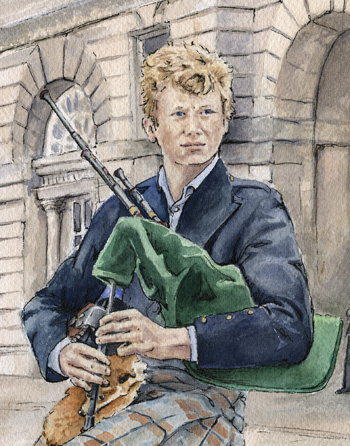
copyright 2016 Mollie Bozarth
Opening the window of your apartment on the Royal Mile, you’re met with sights and sounds of a bustling city. Tourists and lorries, street vendors and shop owners create a chatter of activity. This cacophony is part of the music of Edinburgh. However, it’s merely the backdrop for a ribbon of song that floats and weaves through the city street. For, on several corners stand Edinburgh pipers whose bagpipes screel the notes of the nation.
During the several days we spent in or near the Royal Mile, we saw (and listened to) pipers of all ages. Each wore a traditional kilt, some in full regalia. And most played traditional Scottish bagpipes. Then, one day we came across a young piper whose music carried more harmonies, without the shrill drone of Scottish pipes. I asked the young man, whose name is Rex, whether these were Uilleann pipes – an Irish form of bagpipe I’d heard once in college. The Uilleann pipes look a lot like those Rex played. Turns out I was on the right track! Rex was playing a lesser-known instrument called the Scottish smallpipes. In preparation for this blog post, I emailed Rex, asking for more information about smallpipes and his experiences as a piper. Rather than summarize what he said, I’ll share his responses here:
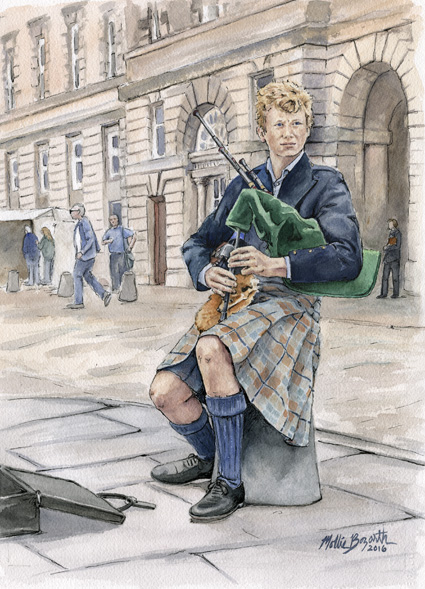
copyright 2016 Mollie Bozarth
Specifics: The ‘Scottish smallpipes’ as played when we met are a less commonly played form of pipes. The more traditional ‘Highland Bagpipes’ are most common. They have a huge link with Scottish culture and are referred to by some as an ‘instrument of war’. The ‘Scottish smallpipes’ are more quiet and usually played in pubs and at local gatherings. Very few people play these and so it takes around 6 months to a year to get a good set from a maker. They have the same finger work as the highland bagpipe although look and are played differently (with a bellow instead of a blowpipe). They are great for playing with other instruments, particularly the guitar whereas the highland bagpipes are more of a solo instrument (unless of course played with drums) The Uilleann pipes, also known as Irish pipes are, in my opinion the holy grail of piping expertise. There is a saying which is: “7 years learning, 7 years practicing, 7 years playing”…21 years to master. They are usually played sitting down and have 2 octaves with wrist actions to hold chords at the same time as playing. These are extremely complex to play and indeed make, which is why it can take several years to get hold of a set.
Deep Waters
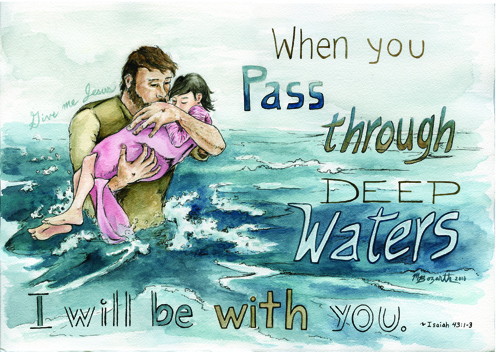
copyright 2016 Mollie Bozarth
Says the LORD, your Creator, O Jacob, and He who formed you, O Israel, “Do not fear, for I have redeemed you; I have called you by name; you are mine! When you pass through deep waters, I will be with you; and through the rivers, you will not drown…For I am the LORD your God, the Holy One of Israel, your savior.” ~ Isaiah 43:1-3
This painting and post are for Ava – an 8-year-old little girl and her family who have been trudging the deep waters of cancer. I cannot fathom what they are going through. Yet, though I only know them through a mutual friend, their story and faith have brought me to tears and put me on my knees in prayer continually over the past several months. I won’t try here to retell their story. Instead, I encourage you to read it yourselves. Ava’s mom has chronicled much of it through a Facebook page called Team Brighter Days.
Many of us know children or loved-ones who have faced debilitating illness. As we walk with them through the impossibly hard days/weeks/years, we fear drowning…drowning in sorrow, anger, exhaustion. Hope can either die or become a rock to cling to in those times. There is no training manual that prepares parents for talking with their children about the possibility of death. Ava has already had those conversations with her parents. More than most children her age, she understands that this world is not her ultimate home. And, while she continues to fight for her life, she also manages to sing the lyrics to one of her favorite songs: “You can have all this world. Give me Jesus.” While we plead with God to touch her cells, heal each one, and allow her many more years on this earth, we also pray that she and her family feel His arms carrying them in the midst of this.
No matter our walk, be it easy or heavy, we all need a savior who will walk beside us, able to relate to what we’re going through. One of the last words I painted in this illustration was the word “with”. As I filled in the letters with a flesh-tone brown, the name Immanuel, which means God with us, came to mind. God came in the flesh to be one of us. When Jesus was 8 days old, a man named Simeon took the baby in his arms, spoke of what his life would one day be, and said to Jesus’ mother, Mary: “A sword will pierce your own soul too.” (Luke 2:21-35) What words to give to a new mother! I’m sure those words came back during the week of Christ’s crucifixion. Beaten, mocked, stripped, and hung on a tree, her boy (age 33 now) would have been barely recognizable. He had the power to heal, walk on water, raise people from the dead – yet he allowed himself to be overcome by death. Did Mary understand that death could only hold him down for 3 days? I think many mothers can relate to Mary, guessing that she wrestled with warring emotions of hope and despair. Michelangelo, in his sculpture Pieta, depicts Mary holding her son after his body’s been retrieved from the cross. While Jesus’ body seems limp and lifeless, his calf-muscle is tense in the sculpture. Michelangelo, who dissected cadavers and knew muscle tone better than any painter or sculptor of his time, would not have accidentally carved that muscle in a flexed/tense position. I believe (as others do) that he used it as a foreshadowing of the resurrection. Yes, Mary’s son was dead. But death could not hold him down. He would soon declare permanent victory over the grave. (1 Corinthians 15:54-57)
son after his body’s been retrieved from the cross. While Jesus’ body seems limp and lifeless, his calf-muscle is tense in the sculpture. Michelangelo, who dissected cadavers and knew muscle tone better than any painter or sculptor of his time, would not have accidentally carved that muscle in a flexed/tense position. I believe (as others do) that he used it as a foreshadowing of the resurrection. Yes, Mary’s son was dead. But death could not hold him down. He would soon declare permanent victory over the grave. (1 Corinthians 15:54-57)
The man Jesus who walked on water, who walked through Hell, and defeated death itself, now walks with us through the deepest waters. Rivers cannot overwhelm us. The grave cannot swallow us. Because when we lack the strength to stand, he carries us. And when we’ve lost even the will to hold on, he won’t let us go.
Portraits of Scotland – Aileen
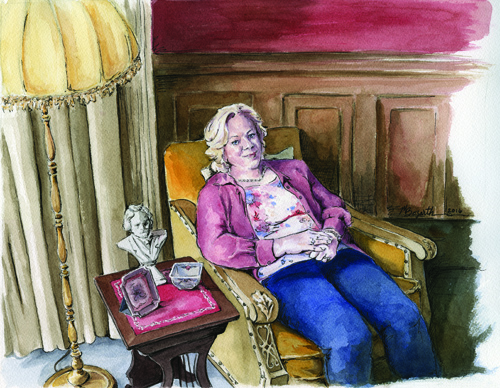
copyright 2016 Mollie Bozarth
One of the leading industries in Scotland, tourism employs over 210,000 people and rakes in almost £6.4 billion annually (according to scotland.org). Not hard to believe, considering B&Bs, self-catering rentals, and guest houses line the streets of every scenic village…and in Scotland, nearly every village is scenic! Where the terrain is too rugged for a B&B, camping tents cluster along streams and cliff-sides. My parents and I stuck with the more conventional housing options. So, during our month’s travels, we encountered a wide variety of hosts and hostesses. Some were chatty, some shy, and others business-like. Many had moved from England to Scotland because they loved the land and its people. Others had been born and bred in the area. A few learned the hospitality gig from their parents. Others left the “dog-eat-dog” business world for a more relaxed lifestyle. But whatever their age, disposition, or background, they all share certain qualities: a knack for hospitality, the ability to organize and run a busy household, tremendous cooking skills, deep love for the country around them, and a breadth of knowledge about their home’s history and the surrounding town/village.
Nine years ago, my parents stayed at The Victorian Townhouse in Edinburgh. This trip, Mom and I decided to return there for our Edinburgh stay. Mom remembered Aileen (pronounced Ay-leen with emphasis on the first syllable) as a friendly hostess who took great care of them in 2007. She was right! Aileen took wonderful care of us. She rents out 3 rooms on the lower level of the house. The upper level is occupied by herself (and previously) her son. The accommodation and treatment were fancier than anything we’d come across previously. High ceilings and window looking onto a back garden, ornate fireplace, large bathroom, and a sitting area with tea and snacks on-hand. We enjoyed getting to know our hostess and the other guests at breakfast each morning. And, upon request, Aileen took us upstairs to visit the Victorian parlour. This room has tall windows looking out onto Eglinton Crescent. The ornate tray ceiling, rich wooden wainscoting, and Persian rug with brushed tassels all harken back to quieter times. This particular townhouse was the childhood home of one of our favorite Scottish authors – D.E. Stevenson. Dorothy Emily was the cousin of Robert Louis Stevenson. While not as well-known as Robert Louis, she has a wide fan-base even to this day. Her books are novels about family life in England and Scotland, written from the 1930s-1970s. My personal favorites are Miss Buncle’s Book (recently made into a play, and possibly going to be made into a BBC movie), The Tall Stranger, and The Five Windows. During our Edinburgh stay, Mom and I actually stumbled across a treasure-trove of D.E. Stevenson books! They were tucked into a corner of an establishment called (appropriately enough) Edinburgh Books on West Port Road. The City of Edinburgh placed a plaque commemorating her birthplace at The Victorian Townhouse this very month! Seeing Aileen’s Victorian parlour, we could imagine D.E. Stevenson as a small girl…peering out the front window at people passing in the cobbled street, sitting by the large fireplace on chilly nights, ringing the bell to summon servants for tea. Our stay with Aileen was the perfect end to a memorable month in Scotland!
About the artwork:
For many illustrations in my series, I simply asked the person in passing permission to photograph them for a portrait. In Aileen’s case, I wanted to set her up in the Victorian room and do a more formal photo-shoot. While her cooking clothes and apron might have represented the everyday aspect of her position, The Victorian Townhouse hostess should have a chance to show off her string of pearls and stately sitting-room. Mom and I chatted with her for nearly an hour while I snapped photos. The photo-shoot itself was as fun as the actual painting of her portrait!
Portraits of Scotland – Leather Artisan
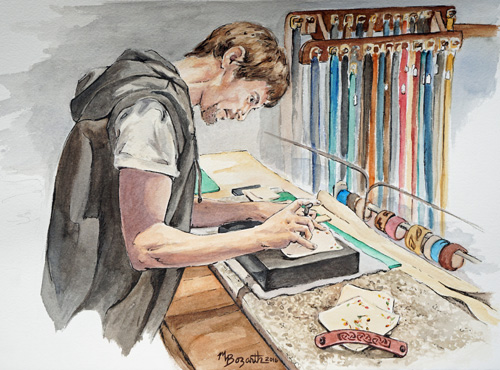
copyright 2016 Mollie Bozarth
Tucked away, merely steps from Tobermory Main Street, is a small store where old meets new. You enter a shop where the walls, paint, carpet and furnishings are modern, clean lines. Yet behind the workbench stands a man whose craft dates back hundreds (if not thousands) of years. Alan Willetts taught himself leatherwork as a hobby. But the deeper he got into the craft, the more dissatisfied he was with his regular job. So, he opened up shop. Now, with both a store-front and an online site, he can be found working long hours at what he loves best. I stepped into the store out of curiosity. But both the artisan and his skill quickly caught my attention. One wall is a rainbow of earth tones, belts of all lengths and colors. In front of the workbench hang a row of leather bracelets with tooled or embossed designs. By the window are tables of wallets, journal covers, and other items, each hand-stitched and completely hand-crafted. We asked Alan if he might show us the tooling process. His eyes lit up as he explained various thicknesses of leather, demonstrating how to carve, emboss, and paint a leafy vine. He’s even designed a map of the Isle of Mull, made from his vine and leaf pattern. Mom and I would be leaving town soon, but we ventured to ask if he could finish a couple items for us if we placed an order. He was able to complete the order, and had both items ready by the following evening! Not long after we left the shop, Mom said, “You should see if he’d let you take photos to do a portrait of him!” So, when I returned to the shop to pick up our order, I brought my camera. Alan’s one comment was, “How does my hair look?” I assured him it looked fine! And we set up the shots that became the above illustration. I love that the photos (and painting) caught his intensity of expression as he concentrated on carving. This is a man in his element who puts ingenuity and time into every inch of every piece he creates. In a world and time where mass-production factory output is the norm, it’s refreshing to visit a place where time slows down while an artist hones his craft.
Portraits of Scotland – Dunvegan Gardener

copyright 2016 Mollie Bozarth
When I told my friend that I’d toured 3 castles during my first 3 days in Scotland, her thought was, “If you’ve seen one castle, haven’t you seen them all?” However, having visited several of Scotland’s castles this month, I can safely say that no two are alike! No one can accuse Scotland of lacking castles. I’d be interested to know what the ratio is per square mile. Some castles are mere ruins; others have been occupied by families and/or clan leaders longer than America’s existed as a country. Urquhart Castle (pronounced Er-keht), which looks out over Loch Ness, was purposefully blown up by its owners to keep Jacobite forces from taking control. Many castles are simple fortresses to claim or protect territory. Others were built as protective walls, with a village of people or armies living inside. Some were built for glory, (then torn down and rebuilt even larger) to declare the owner’s wealth. Each is famous in its own right. But a few are famous for their gardens. When a family has lived in one place for generations, they have time to cultivate trees, flower-beds, walled gardens, waterfalls, in some areas of Scotland even tropical plants. Think of it as “Let’s plant a bush for Mom for Mother’s Day”…then times that by several hundred Mother’s Days.
One garden especially well-known on the Isle of Skye is Dunvegan Castle garden. When you walk down Dunvegan paths, you feel as though you’ve stepped into a scene from The Secret Garden. Natural waterfalls tumble into streams, with foot-bridges crossing them. A fence constructed of sawn branches lines walkways, blending in naturally with its surroundings. The Walled Garden houses more protected plants, including a lily pond with deep pink waterlilies gracing the tranquil surface. Meanwhile, the Round Garden has sections of open lawn and monkey puzzle trees stretching up to the sky. Everywhere color explodes around you in flowers of all kinds, each labeled with name and Latin classification for those who care to know what they’re seeing.
Of course, these gardens don’t take care of themselves. Acres of manicured beds, trimmed hedges, and weed-free paths require work. So, today’s portrait is dedicated to the many gardeners working behind the scenes to maintain a castle garden’s majesty. This particular portrait is a woman who works part-time at Dunvegan. In the few minutes I spoke with her, it was evident that gardening is both an enjoyment and a labor of love. She seemed a quiet individual; perhaps shy, but happy to talk about the plants in her care. Each gardener is given a particular section of the grounds to maintain. Her segment includes Rhododendron hedges (Scotland’s famous weed), spotted with pale pink blossoms. It also includes several beds with springy green heather tucked amongst the flowers. As I photographed her, she was trimming the heather. When I asked when the heather blooms, she told me that this is a garden-variety heather that blooms in spring. The wild heather which transforms Scotland’s hills to gorgeous purple will bloom later this summer or early autumn. An old wheel barrow with tools and extra flowers stood nearby. And as we finished our conversation, she paused to put on “midgie gear,” a net-like head covering to protect her from midge bites. For those who don’t know, the midge is the national bird of Scotland. Just kidding! However, they are like tiny gnats that swarm and leave you itching. In a garden that looks like paradise, midges remind you you’re definitely on earth. With her midge protection in place, the Dunvegan gardener continued quietly and happily, content in her work.
Portraits of Scotland – Near Neighbors
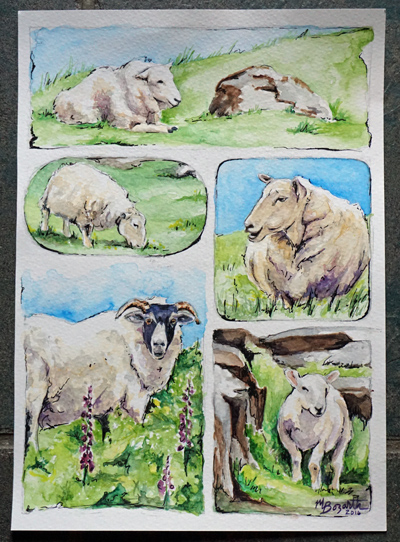
copyright 2016 Mollie Bozarth
When you’re in the highlands, you may live in a village with houses clustered together, or your home may be tucked into a hillside at the end of a cart-track. Whichever the case, your nearest neighbors are bound to be hundreds of sheep. These neighbors can be found gamboling down the road next to (or in front of) your car. They camouflage with boulders on the hillsides, making you think: “I could have sworn that was a rock, but it just moved!” In rain or sun, high wind or gentle breeze, they seem to be forever grazing, head down, munching and roaming and munching again. If no sheep is within view at the moment, just listen. You’ll hear the “maaa” carrying across from a loch or hill behind you. After visiting the highlands, I now understand why streets in Edinburgh are lined with shops advertising Harris Tweed, lamb’s wool scarves, cashmere sweaters, and haggis. In a land of rocks, boulders, and turf (where even houses, walls, and barns are built from those very materials) farming sheep is both a way of life and a necessity.
Having grown up in the church, I’ve long been familiar with passages comparing humanity to sheep. Jesus grew up in a land like Scotland, with rough, rocky terrain well-suited to sheep-farming. I grew up in the wilds of Naperville, where soybeans and sod farms are pushed aside by shopping centers. Sheep are scarce, if non-existent. If you pause and listen, you’ll hear the rumble of a semi-truck, not the bleating of lambs. So, while Jesus’ listeners could easily relate to his parables about sheep, I’ve had to use my imagination. Visiting the highlands has breathed fresh life into the realities of his comparison.
This Sunday my family visited a church in Carloway (Isle of Lewis), where the pastor was preaching on Matthew 18:1-14 & 19:13-15. The passages focus on Jesus’ interactions with children and how we must become like children (as regards faith) in order to enter God’s kingdom. Pastor Davis talked about how children don’t know what they need, but they know who they need. A baby may refuse to eat because she’s gotten so worked up about being hungry. In her anger, she doesn’t realize that what she needs is being offered to her. Yet, from her earliest weeks she knows her mother and father’s voices (she’s been listening to them for 9 months in the womb). So, even if she’s too upset to know what she needs, she knows who to go to for comfort and provision. Pastor said that as adults, we have a pretty good idea of what we need. But we don’t know where to look or who to go to for provision. Instead of going to our heavenly Father (who knows and has what we truly need) we look for fulfillment in relationships, success, binges, etc. I confess I’m guilty of looking/searching for the next ____________ (fill in the blank) of life…the next stage (marriage/family), the next success, or the next book publisher. I often feel God tapping me on the shoulder, saying, “Mollie, slow down. What’s right in front of you – what I’ve provided – is all you need for now. Enjoy it! Be still in the midst of it. Stop searching for more when you’re not even sure what ‘more’ implies.”
In the midst of Jesus’ teaching on childlike faith, he interweaves a comparison to sheep (18:12-14). This comparison got me thinking about the similarities between sheep and children. Children implicitly trust the parent who loves them. Sheep implicitly trust the shepherd who cares for them. Children wander off, need guidelines/boundaries to feel safe, and sometimes need rescuing from foolish mistakes. Sheep are the same way. Children can identify their parents from across a crowded store, simply by hearing mom or dad cough. A sheep knows the shepherd’s voice and will ignore or run away from a stranger’s voice (John 10:4-5). This last comparison has gained new meaning for me here in Scotland. I’ve always heard that sheep run from a stranger’s voice. Yet, I will stand with my camera on the hills of Skye and call out to a sheep…trying to get it to look up from its munching so that I can take a good photo. I’ve even tried talking the sheep’s language (not Gaelic but “maaa”…and, yes, I’ve seen tourists from Germany and China doing the same thing). Inevitably, the sheep ignores me. If I approach her, she shows me her backside and walks away. That sheep knows I care little for her, beyond a photo opportunity. On the flip-side, I met a shepherdess last week. When I asked Linda if she would be sheering any sheep in the next day or so, she replied that the weather was awful and “the girls wouldn’t like it.” Linda knows her sheep. She loves, protects, provides for each one. Just as a trusting child, those sheep could identify her voice in any crowd.
In wrapping up his sermon, Pastor Davis concluded: as we approach God, our mindset must be that of a child. We should approach Him in humility, understanding our inability to supply our own needs. We should approach with a trusting heart, as children run with open arms to their parents’ protective embrace. We should seek to obey our Father’s voice as children who understand that rules aren’t about constriction but simply provide safety. And we should honor our heavenly Father as a child would brag about the strength of his dad. May I have the childlike (and sheeplike) faith to always trust that voice I know so well. May I always remember who to look to, even when I think I know what I need.
Borrowers
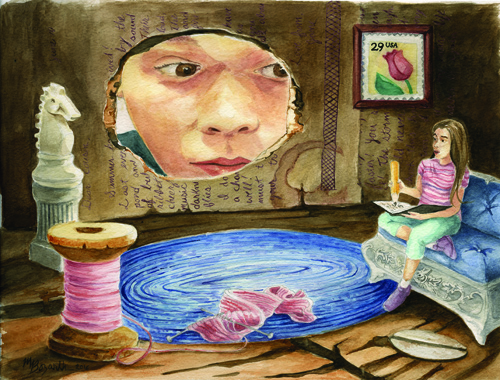
copyright 2016 Mollie Bozarth
What happens to your household items when they go missing? Why do hairpins and spools of thread vanish? Where did your pencil go when you know you set it on the table? What about the heirloom pocket-watch you kept so carefully in a dresser drawer? You’ve looked everywhere for one of the knights in your favorite chess set. And, why do Lego pieces regularly disappear? Mary Norton proposed a solution to these mysteries in her Borrowers series, which first came out in 1952. The Borrowers are tiny people who live within the walls of our homes. They believe that the only true purpose for “Human Beans”…as they call us…is to provide the basic necessities for their lifestyle. They have no qualms about taking everything from potatoes to pins to pieces of cloth or paper. According to Mary Norton, their rooms are papered with letters rescued from a trash can. The handwritten script runs as vertical stripes up each wall. A chess piece becomes the marble bust on a column in their living room. Bits of pencil may look like rolling-pins in their hands but are still useful for writing. A Borrower’s main goal, besides living comfortably, is to NEVER be seen by a human. Their fear is that (if seen) the humans may buy a cat or some other deadly pet who would force them out onto the streets, looking for a new home.
Today’s artwork was inspired by the SCBWI prompt – Borrow. While brainstorming ideas, I remembered stories I’d heard as a child. I also remembered a TV cartoon series called The Littles, which I’m guessing was based on The Borrowers. So, I borrowed (no pun intended) my mom’s copy of the book and began researching this month’s illustration. Most aspects of my illustration come from the book…including the wall paper, chess piece, sofa, pencil, diary, wall art, and spool of thread. The girl is based on the main character, Arrietty, age 14. And the boy is a human she meets, age 10. These roles were played by my niece and nephew. While mine is a more modern version of the setting, it remains true to the heart of a Borrowers scene. My aim was to capture the very moment Arrietty is seen (and no, this setting is not true to the book…they first meet outside). It’s that frozen second of calm before the storm, where she’s been writing in her diary and hasn’t even had time to think of escape. I hope you enjoy it! And, if you’re looking for a good book for young readers, check out Mary Norton’s stories!
Tips and tricks connected with this illustration:
Obviously, when compiling photo references for an illustration like this one, you can’t get everything in one shot. First, I made a rough sketch of the poses, expressions and setting needed. I took photos of my nephew looking through a cardboard cut-out hole. He quickly learned that acting surprised while trying not to turn your face (lest you cast shadows in the wrong place) and peering through a hole in cardboard is…tricky! Thankfully, he has a dramatic flair and was up for the challenge. Then, I set my niece up in the pose I’d sketched and took her photos. We placed a chess knight on top of a Lego column for that particular reference, and I took close-up shots from the angle needed. Other items were found online. All images were pieced together in Photoshop. Here I could use the skew and perspective tools to tweak angles. I could play with filters, lighting, layer-effects, and brushes to bring a consistency to the scene as a whole. Once finished, I printed out the compiled reference, projected it onto watercolor paper, and went from there!
Carol – In Remembrance

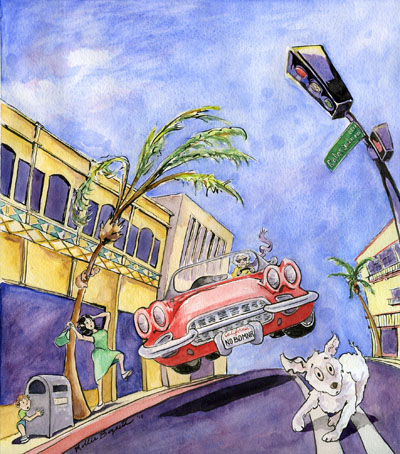
copyright 2009 Mollie Bozarth
Today a mother-figure and mentor has passed away. For those of you who don’t know, I earned my MFA in Illustration through a program at the University of Hartford. Murray Tinkelman (whom I mentioned in my post Autumn Rhythm) is the head of the Hartford MFA program, but I’m sure he would agree that much of the program’s success is due to the tireless efforts and ingenuity of his wife and lifelong teammate, Carol. In a program designed as a tight-knit experience, Carol had the knack of bringing people together who would challenge and inspire one another. She was the mother hen, checking to make sure everyone had what they needed as we traveled to various illustration hubs around the United States. She was the one behind the scenes, getting paperwork together, emailing contacts, communicating with secretaries. She was one tough lady…not a woman whose bad side you would want to be on! Yet, she is beloved because her heart was big, her encouragement far-reaching, and her advice practical. Though I haven’t seen Carol in several years, I kept in touch with her through Facebook. She has checked in on my free-lance work, read my blog, and kept me posted on how she and Murray were doing. She will be greatly missed.
Above is an illustration I did after our Pasadena trip with the Hartford program. After each trip, our assignment was to create a piece based off of the city we had just visited. Throughout our week in Pasadena, the song The Little Old Lady from Pasadena had stuck in my head. Its chorus goes: And everybody’s sayin’ that there’s nobody meaner, Than the little old lady from Pasadena, She drives real fast and she drives real hard, She’s the terror of Colorado Boulevard, It’s the little old lady from Pasadena (Go granny, go granny, go granny, go!). Walking down the sidewalks of Colorado Boulevard, I could picture the granny flying past terrified pedestrians in her bright red sports car. I had originally sketched a boy scout in the dog’s position…playing off the irony of boy scouts’ tradition of helping old ladies cross the street. However, my art director felt having a boy scout dive out of the way seemed too precarious/dangerous. So, the dog running for safety took his place. If you look closely, a squirrel is peeking around the palm tree’s trunk. During our week there, squirrels were prevalent. One squirrel particular came right up to my friend Michael’s feet when we were in the backyard of a famous house. The critter stood up on its hind legs, tame as any pet, and stared at us for several seconds before retreating up a tree. I actually had time to snap a photo of it before it ran! Memories of this trip and many weeks like it will forever be tied to Carol Tinkelman. I hope she knows what an impact she had on countless lives, including mine.
